- Election 2024
- Entertainment
- Newsletters
- Photography
- Personal Finance
- AP Investigations
- AP Buyline Personal Finance
- AP Buyline Shopping
- Press Releases
- Israel-Hamas War
- Russia-Ukraine War
- Global elections
- Asia Pacific
- Latin America
- Middle East
- Election Results
- Delegate Tracker
- AP & Elections
- Auto Racing
- 2024 Paris Olympic Games
- Movie reviews
- Book reviews
- Personal finance
- Financial Markets
- Business Highlights
- Financial wellness
- Artificial Intelligence
- Social Media

EXPLAINER: What’s the state of Russia’s missile arsenal?
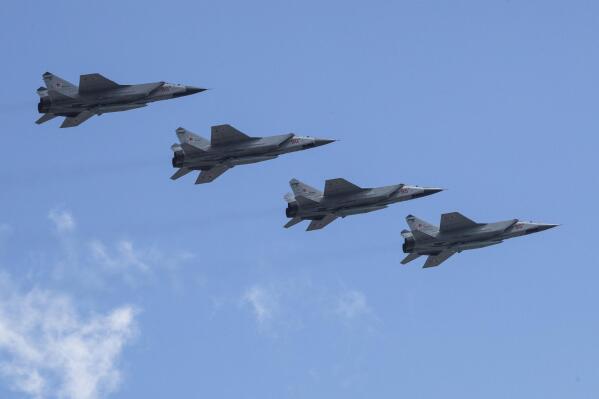
FILE - Russian’s Air Force Mikoyan MiG-31K jets carrying Kh-47M2 Kinzhal nuclear-capable air-launched ballistic missiles fly over Red Square during a rehearsal for the Victory Day military parade in Moscow, Russia, on May 7, 2021. As Russia bombarded Ukraine this week, military observers were left wondering about how many and what types of missiles Russia still has in its arsenal. In other words, how long can the Kremlin keep up the barrage? (AP Photo, File)
FILE Russian the S-300 air defense missile systems drive during the Victory Day military parade marking 71 years after the victory in WWII in Red Square in Moscow, Russia, Monday, May 9, 2016. As Russia bombarded Ukraine this week, military observers were left wondering about how many and what types of missiles Russia still has in its arsenal. In other words, how long can the Kremlin keep up the barrage? (AP Photo, File)
FILE In this image taken from video released by Russian Defense Ministry Press Service on Saturday, May 28, 2022, a new Zircon hypersonic cruise missile is launched by the frigate Admiral Gorshkov of the Russian navy from the Barents Sea. The ministry said the recently developed Zircon hypersonic cruise missile had struck its target about 1,000 kilometers away. As Russia bombarded Ukraine this week, military observers were left wondering about how many and what types of missiles Russia still has in its arsenal. In other words, how long can the Kremlin keep up the barrage? (Russian Defense Ministry Press Service via AP, File)
FILE - Russian President Vladimir Putin chairs a Security Council meeting via videoconference in St. Petersburg, Russia, Monday, Oct. 10, 2022. Putin recently chaired a meeting to discuss plans for boosting weapons production, but he steered clear of specifics in televised introductory remarks. As Russia bombarded Ukraine this week, military observers were left wondering about how many and what types of missiles Russia still has in its arsenal. In other words, how long can the Kremlin keep up the barrage? (Gavriil Grigorov, Sputnik, Kremlin Pool Photo via AP, File)
FILE - In this photo taken from a footage released on Sept. 22, 2020 by the Russian Defense Ministry Press Service, a rocket launches from a missile system at the Ashuluk military base in Southern Russia. As Russia bombarded Ukraine this week, military observers were left wondering about how many and what types of missiles Russia still has in its arsenal. In other words, how long can the Kremlin keep up the barrage? (Russian Defense Ministry Press Service via AP, File)
FILE - A Russian military officer walks past the 9M729 land-based cruise missile on display with its launcher, right, in Kubinka outside Moscow, Russia, Wednesday, Jan. 23, 2019. As Russia bombarded Ukraine this week, military observers were left wondering about how many and what types of missiles Russia still has in its arsenal. In other words, how long can the Kremlin keep up the barrage? (AP Photo, File)
FILE - Russian Buk-M2 air defense missile systems drive down Red Square during a rehearsal for the Victory Day military parade in Moscow, Russia, Tuesday, May 7, 2019 . As Russia bombarded Ukraine this week, military observers were left wondering about how many and what types of missiles Russia still has in its arsenal. In other words, how long can the Kremlin keep up the barrage? (AP Photo, Pool, File)
FILE - Russian Buk-M3 surface-to-air missile system rolls along Red Square during a rehearsal for the Victory Day military parade in Moscow, Russia, Friday, May 7, 2021. As Russia bombarded Ukraine this week, military observers were left wondering about how many and what types of missiles Russia still has in its arsenal. In other words, how long can the Kremlin keep up the barrage? (AP Photo, File)
FILE - Russian surface-to-air missile and anti-aircraft artillery weapon system Pantsir-S1 roll along Red Square during a rehearsal for the Victory Day military parade in Moscow, Russia, Friday, May 7, 2021.As Russia bombarded Ukraine this week, military observers were left wondering about how many and what types of missiles Russia still has in its arsenal. In other words, how long can the Kremlin keep up the barrage? (AP Photo, File)
FILE - Russian RS-24 Yars ballistic missiles roll during a dress rehearsal for the Victory Day military parade in Red Square in Moscow, Russia, Friday, May 7, 2021. As Russia bombarded Ukraine this week, military observers were left wondering about how many and what types of missiles Russia still has in its arsenal. In other words, how long can the Kremlin keep up the barrage? (Russian Defense Ministry Press Service via AP, File)
FILE - In this file photo taken on Wednesday, May 9, 2018, a Russian Air Force MiG-31K jet carries a high-precision hypersonic aero-ballistic missile Kh-47M2 Kinzhal during the Victory Day military parade to celebrate 73 years since the end of WWII and the defeat of Nazi Germany, in Moscow, Russia. As Russia bombarded Ukraine this week, military observers were left wondering about how many and what types of missiles Russia still has in its arsenal. In other words, how long can the Kremlin keep up the barrage? (AP Photo, File)
FILE - In this photo taken from video and released by the Russian Defense Ministry Press Service on Friday, Feb. 4, 2022, multiple rocket launchers fire during the Belarusian and Russian joint military drills at Brestsky firing range, Belarus. As Russia bombarded Ukraine this week, military observers were left wondering about how many and what types of missiles Russia still has in its arsenal. In other words, how long can the Kremlin keep up the barrage? (Russian Defense Ministry Press Service via AP, File)
FILE - In this file photo taken from a video distributed by Russian Defense Ministry Press Service, on Dec. 9, 2020, a ground-based intercontinental ballistic missile was launched from the Plesetsk facility in northwestern Russia. As Russia bombarded Ukraine this week, military observers were left wondering about how many and what types of missiles Russia still has in its arsenal. In other words, how long can the Kremlin keep up the barrage? (Russian Defense Ministry Press Service via AP, File)
FILE - Crows fly over an anti-aircraft missile installed on a warship at a Navy base in Kronstadt, outside St. Petersburg, Russia, Monday, April 4, 2022. As Russia bombarded Ukraine this week, military observers were left wondering about how many and what types of missiles Russia still has in its arsenal. In other words, how long can the Kremlin keep up the barrage? (AP Photo, File)
FILE - In this handout photo released by Russian Defense Ministry Press Service on Wednesday, April 20, 2022, the Sarmat intercontinental ballistic missile is launched from Plesetsk in Russia’s northwest. After Russian unleashed missile attacks across Ukraine this week, military observers were left wondering about how many and what types of missiles Russia still has. That is, how long will the Kremlin be able to keep hitting Ukrainian cities? (Russian Defense Ministry Press Service via AP, File)
FILE - Russian S-400 anti-aircraft missile system launchers roll during a rehearsal for the Victory Day military parade which will take place at Dvortsovaya (Palace) Square on May 9 to celebrate 77 years after the victory in World War II in St. Petersburg, Russia, Thursday, May 5, 2022. After Russian unleashed missile attacks across Ukraine this week, military observers were left wondering about how many and what types of missiles Russia still has. That is, how long will the Kremlin be able to keep hitting Ukrainian cities? (AP Photo, File)
FILE - This photo taken from video provided by the Russian Defense Ministry Press Service on Saturday, Feb. 19, 2022, shows a Russian Iskander-K missile launched during a military exercise at a training ground in Russia. The Russian military on Friday announced massive drills of its strategic nuclear forces. After Russian unleashed missile attacks across Ukraine this week, military observers were left wondering about how many and what types of missiles Russia still has. That is, how long will the Kremlin be able to keep hitting Ukrainian cities? (Russian Defense Ministry Press Service via AP, File)
FILE - Russian RS-24 Yars ballistic missiles roll during the Victory Day military parade in Moscow, Russia, Monday, May 9, 2022, marking the 77th anniversary of the end of World War II. After Russian unleashed missile attacks across Ukraine this week, military observers were left wondering about how many and what types of missiles Russia still has. That is, how long will the Kremlin be able to keep hitting Ukrainian cities? (AP Photo, File)
FILE - In this photo taken from a video distributed by Russian Defense Ministry Press Service, on Dec. 9, 2020, a Russian Tu-160 strategic bomber fires a cruise missile at test targets, during a military drills, Russia. After Russian unleashed missile attacks across Ukraine this week, military observers were left wondering about how many and what types of missiles Russia still has. That is, how long will the Kremlin be able to keep hitting Ukrainian cities? (Russian Defense Ministry Press Service via AP, File)
- Copy Link copied
WASHINGTON (AP) — As Russia bombarded Ukraine this week, military observers were left wondering about how many and what types of missiles Russia still has in its arsenal. In other words, how long can the Kremlin keep up the barrage?
Some analysts believe Russia could be running down its stockpiles of long-range precision weapons as the nearly 8-month-old war drags on and sanctions hit its economy, forcing it to resort to less-accurate missiles.
It remains unclear if Russia has enough weapons to continue the strikes against Ukraine with the same intensity that began following the Oct. 8 explosion on the Kerch Bridge to the Moscow-annexed Crimean Peninsula.
A look at what is known — and not known — about Russia’s arsenal:
WHAT DOES RUSSIA SAY?
Russian officials say the military has sufficient stockpiles of long-range missiles and that factories are churning out more, rejecting Western claims its supplies are shrinking.
The Russian military hasn’t said how many missiles it has fired and how many are left, and there is no data to independently assess the state of the Russian arsenal.
President Vladimir Putin recently chaired a meeting to discuss plans for boosting weapons production, but he steered clear of specifics in the introductory remarks that were televised.
WHAT HAS RUSSIA RELIED ON RECENTLY?
When the Russian military unleashed missile attacks across Ukraine starting Monday, it used the entire range of its long-range precision weapons: the Kh-55 and Kh-101 cruise missiles fired by strategic bombers, the sea-launched Kalibr cruise missiles and the ground-launched Iskander missiles.
Russian forces have also repeatedly used the S-300 surface-to-air defense missile systems for striking ground targets, which was seen by some observers as a sign of a Russian weapons shortages.
Russia’s repurposing of air defense systems and anti-ship missiles suggests it is running low on more advanced missiles that are intended to hit ground targets, said Ian Williams, a fellow at the Washington-based Center for Strategic and International Studies.
Strikes from a Russian S-300 air defense system “don’t have the ‘oomph’ to really hit hardened military targets and they don’t have the accuracy in a land attack role to even strike the building you want to hit,” Williams said. “This really is just firing them into the ether and seeing where they land.”
Their use, however, could be explained by an abundant stock of older subtypes of such missiles, which were superseded by more advanced air defense weapons, as well as the military’s desire to keep more expensive, advanced long-range missiles for priority targets.
While numbers are hard to obtain, how Russia is using its weapons is telling. In a recent strike in Mykolaiv, a surface-to-air missile was used to hit a target on the ground.
Douglas Barrie, senior fellow for military aerospace at the London-based International Institute for Strategic Studies, called that “a sure sign that missile stocks are running low.”
WHAT IS WASHINGTON SAYING?
While the Biden administration believes there is evidence that Russia has depleted stocks of its most efficient weapons, U.S. officials say there is no sign Moscow is ready or willing to relent in its recent barrages against civilian areas in Kyiv and other Ukrainian cities.
It was not immediately clear what the U.S. thinks Russia might have left. But two officials said U.S. government analysts had noted with interest that Russia had used cruise missiles, and not less expensive, shorter-range artillery or rockets, in the aftermath of the Kerch Bridge blast.
That choice, the officials said, could indicate that Russia is running low on cheaper, reliable mid-range weapons and is having trouble replenishing its stockpiles due to sanctions and supply chain disruptions.
The relative calm that Kyiv enjoyed prior to the Kerch Bridge incident may have been a sign that Russia was trying to conserve its limited resources, according to the officials, who spoke on condition of anonymity to discuss internal assessments of Russia’s military strength.
WHAT’S BEHIND THE CHOICE OF TARGETS?
Firing large numbers of inaccurate missiles could be intended to clutter air defenses while Russia uses its best missiles for high-value targets and key infrastructure.
But Williams suggested that Moscow could also be acting strategically, knowing its barrage will hit civilian targets in hopes of driving up panic in Ukraine and pushing Kyiv to accept a cease-fire favorable to Russia.
“It’s becoming more and more clear that, as they say, the cruelty is the point,” he said.
Tara Copp in Washington contributed.
Follow the AP’s coverage of the war at https://apnews.com/hub/russia-ukraine
Advertisement
Supported by
Russian Cruise Missiles Were Made Just Months Ago Despite Sanctions
Weapons investigators in Kyiv found that at least one Russian Kh-101 cruise missile used in widespread attacks there on Nov. 23 had been made no earlier than October.
- Share full article

By John Ismay
Some of the cruise missiles that Russia launched at Ukraine’s civilian infrastructure in late November were manufactured months after the West imposed sanctions intended to deprive Moscow of the components needed to make those munitions, according to a weapons research group.
Experts examined remnants of Kh-101 cruise missiles found in Kyiv, the capital, after an attack on Nov. 23 that knocked out electricity and shut down water systems in large areas of the country. One of the missiles was made this summer, and another was completed after September, markings on the weapons show, according to a report released by the investigators on Monday .
That Russia has continued to make advanced guided missiles like the Kh-101 suggests that it has found ways to acquire semiconductors and other matériel despite the sanctions or that it had significant stockpiles of the components before the war began, one of the researchers said.
The findings are among the most recent by Conflict Armament Research , an independent group based in Britain that identifies and tracks weapons and ammunition used in wars. A small team of its researchers arrived in Kyiv just before the attack at the invitation of the Ukrainian security service.
In four previous research trips to Kyiv since the invasion, the investigators found that almost all of the advanced Russian military gear they examined — like encrypted radios and laser range finders — was built with Western semiconductors.
The investigators were unable to determine whether the Kh-101 remnants they studied were from missiles that reached their targets and exploded or were intercepted in flight and shot down.
The Kh-101 missiles were marked with a 13-digit numerical sequence. The investigators said they believe that the first three digits represent the factory where the missile was made, followed by another three-digit code indicating which of two known versions of the Kh-101 it is and two digits indicating when it was manufactured. A final string of five numbers is believed to denote the missile’s production batch and serial number.
Piotr Butowski, a Polish journalist who has written extensively about Russia’s warplanes and military munitions, said the group’s numerical analysis matched up with his research.
“The first three digits are always ‘315’ — this is the production facility code,” Mr. Butowski said in an email. “Kh-101 missiles are developed and manufactured by the Raduga company in Dubna near Moscow.”
In an interview before the report was released, a U.S. defense intelligence analyst said that Mr. Butowski’s analysis was consistent with the government’s understanding of how Russian missile producers — including those that make the Kh-101 — mark their weapons. The official, who was not authorized to speak publicly, said Russia was generally believed to be experiencing ammunition stockpile problems and may be using newer munitions alongside those that are much older.
The analyst said that reports from Russia indicate that the government has ordered employees at munition plants to work additional hours in an effort to produce more ordnance, and that it is clear that Russia is now firing fewer long-range weapons like cruise missiles at a smaller number of targets in Ukraine.
Pentagon officials say Russia has fired thousands of long-range weapons like cruise missiles as well as short- and medium-range ballistic missiles at targets in Ukraine since the war began.
Whether Russia has depleted its inventory of older cruise missiles is unclear. But militaries often use older munitions first in combat because they typically make up a majority of a nation’s stockpile.
On Nov. 23, the same day as the cruise missile attack on Kyiv, Lloyd J. Austin III, the secretary of defense, told reporters that Russia’s supply of precision-guided weapons had been “significantly reduced” and that it would be more difficult for Russia to rapidly produce them “because of the trade restrictions they have on microchips and other types of things.”
But Damien Spleeters, who led Conflict Armament Research’s investigation, said it would be difficult to say that the Russians are running short on weapons.
“Those claims have been made since April,” he said, “so we’re just pointing to the fact that these cruise missiles being made so recently may be a symptom of that, but it’s not a certainty.”
John Ismay is a Pentagon correspondent in the Washington bureau and a former Navy explosive ordnance disposal officer. More about John Ismay
Programs submenu
Regions submenu, topics submenu, strengthening nato's european pillar, the impossible state live podcast: can south korea save ukraine, the strategic value of modern grid technologies, today’s threats, tomorrow’s health: a discussion with cdc leaders.
- Abshire-Inamori Leadership Academy
- Aerospace Security Project
- Africa Program
- Americas Program
- Arleigh A. Burke Chair in Strategy
- Asia Maritime Transparency Initiative
- Asia Program
- Australia Chair
- Brzezinski Chair in Global Security and Geostrategy
- Brzezinski Institute on Geostrategy
- Chair in U.S.-India Policy Studies
- China Power Project
- Chinese Business and Economics
- Defending Democratic Institutions
- Defense-Industrial Initiatives Group
- Defense 360
- Defense Budget Analysis
- Diversity and Leadership in International Affairs Project
- Economics Program
- Emeritus Chair in Strategy
- Energy Security and Climate Change Program
- Europe, Russia, and Eurasia Program
- Freeman Chair in China Studies
- Futures Lab
- Geoeconomic Council of Advisers
- Global Food and Water Security Program
- Global Health Policy Center
- Hess Center for New Frontiers
- Human Rights Initiative
- Humanitarian Agenda
- Intelligence, National Security, and Technology Program
- International Security Program
- Japan Chair
- Kissinger Chair
- Korea Chair
- Langone Chair in American Leadership
- Middle East Program
- Missile Defense Project
- Project on Critical Minerals Security
- Project on Fragility and Mobility
- Project on Nuclear Issues
- Project on Prosperity and Development
- Project on Trade and Technology
- Renewing American Innovation Project
- Scholl Chair in International Business
- Smart Women, Smart Power
- Southeast Asia Program
- Stephenson Ocean Security Project
- Strategic Technologies Program
- Transnational Threats Project
- Wadhwani Center for AI and Advanced Technologies
- All Regions
- Australia, New Zealand & Pacific
- Middle East
- Russia and Eurasia
- American Innovation
- Civic Education
- Climate Change
- Cybersecurity
- Defense Budget and Acquisition
- Defense and Security
- Energy and Sustainability
- Food Security
- Gender and International Security
- Geopolitics
- Global Health
- Human Rights
- Humanitarian Assistance
- Intelligence
- International Development
- Maritime Issues and Oceans
- Missile Defense
- Nuclear Issues
- Transnational Threats
- Water Security
Russia Isn’t Going to Run Out of Missiles

Photo: CHRISTOF STACHE/AFP/Getty Images
Commentary by Ian Williams
Published June 28, 2023
Long-range missile strikes against Ukrainian cities and infrastructure have been a prominent and persistent aspect of the Kremlin’s war against Ukraine. Earlier this year, the CSIS report Putin’s Missile War found that Russian missile attacks in 2022 had caused major damage to Ukraine’s economy and infrastructure but had failed to achieve the kind of decisive strategic effects that Moscow had likely sought. Into 2023, Russia has persisted in expending expensive, long-range missiles in regular attacks against a variety of civilian and military objects across Ukraine. The focus of these strikes regularly shifts and their intensity has ebbed and flowed, as has the quality of employed munitions.
However, Russia’s continued strike campaign in 2023 has made one thing quite clear: it is unrealistic to expect Russia to ever “run out” of missiles. Despite sanctions and export controls, it appears likely that Russia will be able to produce or otherwise acquire the long-range strike capacity necessary to inflict significant damage upon Ukraine’s people, economy, and military. Ukraine’s air defenses have performed remarkably well under challenging circumstances. Nevertheless, the Russian military has continued trying to identify gaps and seams to exploit to gain an advantage.
There is no one-off fix for this problem. Sanctions and export controls can, at most, limit the quantity and quality of strike assets Russia can acquire. The most reliable counter is sustained Western support for Ukrainian air defense forces for the duration of the conflict. The continued, steady provision of air defenses into the foreseeable future will save lives, reduce costs of future reconstruction, and help end the war more quickly by enabling Ukraine’s counteroffensive in the face of superior Russian airpower. Moreover, providing air defenses has also forced Western countries to scale up production of these systems, which could have long-term benefits for Western defense readiness.
Russia’s Latest Assault
In May, Russia renewed its long-range drone and missile attacks on Ukrainian cities. This surge in activity came after a relative period of lull in March and April, following Moscow’s furious yet unsuccessful strike campaign aimed at collapsing Ukraine’s electric grid last winter. Unlike that singularly focused effort, Russia’s recent spate of missile and drone attacks since May has been aimed at a seemingly broader and less predictable target set.
For instance, Russia has used some of its most advanced and expensive missiles in a failed bid to destroy one of Ukraine’s U.S.-German-provided Patriot batteries protecting Kyiv. Moscow likely believed that the prompt destruction of a Patriot battery—one of the costliest weapon systems Ukraine has received—would discourage continued Western military aid. However, this line of attack backfired as the Patriot battery survived nearly unscathed. The Patriot battery reportedly shot down 100 percent of the 34 Iskander and Kinzhal quasi-ballistic missiles Russia has fired at Kyiv as of June 28, weapons that Moscow had once touted as impervious to air and missile defenses.
In other instances, assessing what Russia has been aiming at has been more challenging since most projectiles get shot down. Targets, though, seem to include a mix of critical infrastructure, command and control installations, and other military and civilian targets. Kyiv has borne the brunt of Russia’s latest assault. Still, Russia has, in more recent weeks, expanded its scope to other areas, possibly looking to exploit areas of Ukraine where air defense is thinner. On June 10, Russia struck a Ukrainian air base in Poltava with a complex barrage of eight ballistic and cruise missiles and as many as 35 Shahed-36 one-way attack munitions. Ukraine says it shot down only two cruise missiles, while 15 Shahed-136s made it through Ukrainian defenses. Russia has not carried out a major missile attack on a Ukrainian air base since the early months of the war, and likely that the area lacked the same level of air defense as Kyiv. Poltava probably lacks protection from Patriot, currently Ukraine’s only defense against ballistic missiles.
As with much of Russia’s air campaign against Ukraine, civilians have suffered the most. In many cases, damage to civilian areas has resulted from falling debris from intercepted missiles. Although much less destructive than allowing a missile to strike its target, debris from intercepts can still kill, maim, start fires, and otherwise damage property. In other instances, Russia appears to be attacking civilians directly. On June 13, Russia launched a cruise missile attack against Kryvyi Rih . At least one of the four missiles that got through Ukraine’s defenses struck an apartment building, killing 11.
Overall, the performance of Ukraine’s air defenses has steadily improved since the start of the war, particularly against Russian cruise missiles. Throughout much of Russia’s winter campaign against Ukraine’s electric grid, Ukraine’s Air Force reported intercepting around 70–80 percent of Russian cruise missiles. Since May, Ukraine has reported intercepting around 90 percent of Russian cruise missiles and drones (see below). Ukraine has reported downing nearly 80 percent of air and ground-launched ballistic missile attacks nationwide and 100 percent of ballistic missiles attacking areas where ballistic missile defenses (Patriot) are present. Ukraine only has two Patriot batteries. As such, most of Ukraine lacks any protection from ballistic missiles, as shown by the June 10 Iskander-M strike in Poltava and the June 22 Kh-47 strikes around Dnipro, which Ukraine could not stop.
While lacking the focus of prior phases of Russia’s long-range strike campaign, Russia’s current objectives seem primarily aimed at keeping Ukraine off balance during its counteroffensive operations in the South, to force Ukraine to divert air defense capacity to defend its cities. Given the limited supply of Ukrainian air defenses, a generalized and unpredictable strike campaign forces Ukraine to make difficult tradeoffs between defending its cities and critical infrastructure and providing thicker air defense for its troops on the front lines.
SHORAD Concerns
As Ukraine’s spring counteroffensive has gotten underway, observers are concerned that Ukraine is facing a gap in short-range air defenses (SHORAD) for its advancing troops. Russia’s use of attack helicopters like the Ka-52 armed with laser-guided 9K121 “Vikhr” missiles has been of particular concern to attack advancing Ukrainian armor. These missiles have a range of upwards of 12 kilometers, outside the range of many of Ukraine’s SHORAD systems like Strela, Stinger, StarStreak, and Igla variants. Ukraine’s medium-range air defenses, like IRIS-T, Buk, and NASAMs, are stretched between frontline duty and defending rear areas against long-range attacks. UK Defence Intelligence recently noted that Russia had deployed 20 additional attack helicopters to Berdyansk, and that “in the constant contest between aviation measures and countermeasures,” Russia had temporarily gained the upper hand.
Ukrainian Air Defense Performance by Threat Type, May 1–June 26, 2023

It is unclear how long Russia will be able to maintain this advantage, however. Ukraine already seems to be adapting, claiming to have shot down six Ka-52s and one Mi-24 attack helicopter since June 16. Moreover, Wagner forces shot down as many as seven additional Russian helicopters during its recent mutiny, including one Ka-52. To be sure, Russia’s attack helicopters are not a plentiful asset. Russia started the war with around 150 Ka-52s. It is doubtful that all of these were mission capable. In October 2022, UK Defence Intelligence estimated Russia to have had no more than 90 Ka-52s in service at the war’s commencement. Based on visual analysis by independent observers and reports from the Ukrainian Air Force, Russia has lost as many as 60 Ka-52s since the start of the war from enemy fire as well as accidents. The Ka-52 problem is not insurmountable, and Russia’s attack helicopter force cannot sustain the rate of losses they have sustained over the past week. However, ensuring that Ukraine has adequate medium- and short-range air defenses to support its counteroffensive over the coming months will be vital to its success. Moreover, additional long-range strike assets, such as Army Tactical Missile System (ATACMS) ballistic missiles, would enable Ukraine to better target the bases Russia is using to house and maintain its attack helicopters, many of which are within the borders of Ukraine.
Russia’s Evolving Strike Complex
As early as March 2022, there was much conjecture that Russia’s supply of precision-guided missiles was dwindling . These reports may not have been entirely off the mark. Russia probably did quickly expend the portion of its long-range missile that it had initially allocated to its “special military operation.” Nevertheless, Russia maintained a steady drumbeat of missile strikes against Ukraine, likely by pulling munitions allocated to other theaters and drawing down its strategic reserves. Moreover, Russia has repurposed various surface-to-air and anti-ship missiles for land attack roles. Russia has also continued to manufacture missiles throughout the war, and evidence suggests that most (possibly all) Russian cruise missiles it has in its current inventory come from postwar production.
The exhaustion of prewar missile stockpiles has impacted the composition of current Russian strike salvos. Compared with previous phases of Russia’s air war, the composition of Russian missile attacks has trended away from high-end missile systems like cruise missiles toward cheaper, less capable “low-end” systems like Shahed-136 one-way attack munitions (see below). In the first three months of 2023, during the tail end of Russia’s strike campaign against Ukraine’s electric grid, Shahed-136s accounted for around 40 percent of long-range projectiles fired at Ukraine. Since April, 61 percent of long-range munitions Russia has employed have been Shahed-136 one-way attack munitions. Compared to cruise and ballistic missiles, Shahed-136 are generally easier to shoot down and more vulnerable to cheaper defenses like the German-made Flakpanzer Gepard and other gun-based systems. The Shahed-136’s warhead weight is also only between that of a cruise missile like Kh-101, and therefore causes less damage when they do make it through defenses.
However, the decline in the quality of Russian long-range strike salvos is unlikely to continue. Rather, the overall composition of Russian strike packages will likely level off as Russian missile use becomes fully tethered to how many missiles it can produce. But it is improbable that Russian production of higher-end cruise and ballistic missiles will ever fall to zero. Despite Western sanctions and export controls of key microelectronic components, Russia has been able to find workarounds to continue producing missiles. In May, Ukrainian intelligence estimated that Russia currently manufactures around 60 cruise missiles, five Iskander ballistic missiles, and two Kinzhals monthly. In June, President Zelensky noted that Ukraine continues to find Western-made microelectronic components amongst the wrecks of Russian missiles. These components are likely finding their way into Russia via friendly third parties such as China.
The United States and Europe can and should seek ways to further restrict the flow of dual-use tech components to Russia. It is, however, unrealistic to expect they will be able to completely deprive Russia of the components it needs to manufacture missiles. Sanctions and export controls have never prevented proliferation by a determined state, let alone one with Russia’s size and economic reach. What they can do is make it harder and more expensive, which would limit the number of missiles it can produce. Regardless of how many missiles the Kremlin produces today, it wishes it could make more. Export controls can help limit that potential.
But the upshot is that Russia will continue having the capacity to build missiles and drones and will continue to fire them at Ukraine. This reality will not change until the war ends. Meanwhile, active air defense remains the most reliable counter to Russian missile attacks, requiring continued support and replenishment from Ukraine’s international partners.
Composition of Russian Missile Attacks on Ukraine, January 1–March 31, 2023

Composition of Russian Missile Attacks on Ukraine, April 1–June 22, 2023

Folks Are Getting It
The good news is that Ukraine’s partners seem to understand the air defense imperative and are responding. Ukraine’s most recent military aid packages have been heavy on air defenses.
Since May, the United States announced it would supply Ukraine’s Armed Forces with additional rounds for NASAMS and Patriot, Avenger air defense and Stinger missiles, and HAWK air defense systems. The United States is also supplying Ukraine with older AIM-7 Sparrow missiles, which have been made compatible with Ukraine’s Buk M2 systems, for which Ukraine has ample launchers though few remaining interceptor missiles.
On June 15, the United Kingdom announced a new multinational fund that would be used to procure “hundreds of short and medium range air defense systems” for Ukraine, noting these deliveries would consist “largely of Soviet-era missiles.” The United Kingdom had also announced in mid-May that it would provide additional air defenses to Ukraine, though it did not specify the type.
French president Macron also recently announced that a French/Italian-provided SAMP/T system is now active in Ukraine, protecting “key installations and lives.” Germany delivered the second of four promised IRIS-T SLM air defense systems in April, along with an additional TRML 4D radar. Berlin also announced on June 24 that it plans to provide Ukraine with 45 more Gepard Flakpanzer systems, more than doubling the number Ukraine currently operates.
These contributions to Ukraine, while reducing national stockpiles of munitions in the short term, have the added benefit of bolstering the production lines of several key air defense systems. Having warm production lines for these complex systems could boost U.S. and allied defense readiness in the long term over and above the risks of near-term drawdowns.
For instance, the U.S. Army expects Stinger production to rise by 50 percent by 2025. As part of that ramp-up, at least one critical component of the Stinger has been redesigned in such a way as to overcome current supply chain issues. The United States is also increasing the production of Patriot systems. There are also significant increases in NASAMS production, and the United Kingdom recently announced it was restarting production of its Starstreak air defense system.
No Permanent Fix
Looking ahead, there is no simple solution to the Russian missile problem. Russia will continue to produce and acquire missiles and one-way attack munitions and use them to target Ukraine. Sanctions and export control can make this harder and costlier for the Russians, but they will not stop them. As long as the war continues, Ukraine must maintain a robust air and missile defense, which will require steady support from the United States and its many other international partners.
To this end, Western defense industrial capacity for everything from air defense interceptors to precision-guided munitions needs to be scaled up and new supply chains built. This process will not only help the United States maintain the steady support that Ukraine needs to win the war as quickly as possible, but it will also leave the United States and its allies in a stronger position to deter and defeat future threats.
Ian Williams is a fellow in the International Security Program and deputy director of the Missile Defense Project at the Center for Strategic and International Studies in Washington, D.C.
Commentary is produced by the Center for Strategic and International Studies (CSIS), a private, tax-exempt institution focusing on international public policy issues. Its research is nonpartisan and nonproprietary. CSIS does not take specific policy positions. Accordingly, all views, positions, and conclusions expressed in this publication should be understood to be solely those of the author(s).
© 2024 by the Center for Strategic and International Studies. All rights reserved.

Ian Williams
Programs & projects.
- Air Transport
- Defense and Space
- Business Aviation
- Aircraft & Propulsion
- Connected Aerospace
- Emerging Technologies
- Manufacturing & Supply Chain
- Advanced Air Mobility
- Commercial Space
- Sustainability
- Interiors & Connectivity
- Airports & Networks
- Airlines & Lessors
- Safety, Ops & Regulation
- Maintenance & Training
- Supply Chain
- Workforce & Training
- Sensors & Electronic Warfare
- Missile Defense & Weapons
- Budget, Policy & Operations
- Airports, FBOs & Suppliers
- Flight Deck
- Marketplace
- Advertising
- Marketing Services
- Fleet, Data & APIs
- Research & Consulting
- Network and Route Planning
Market Sector
- AWIN - Premium
- AWIN - Aerospace and Defense
- AWIN - Business Aviation
- AWIN - Commercial Aviation
- Advanced Air Mobility Report - NEW!
- Aerospace Daily & Defense Report
- Aviation Daily
- The Weekly of Business Aviation
- Air Charter Guide
- Aviation Week Marketplace
- Route Exchange
- The Engine Yearbook
- Aircraft Bluebook
- Airportdata.com
- Airport Strategy and Marketing (ASM)
- CAPA – Centre for Aviation
- Fleet Discovery Civil
- Fleet Discovery Military
- Fleet & MRO Forecast
- MRO Prospector
- Air Transport World
- Aviation Week & Space Technology
- Aviation Week & Space Technology - Inside MRO
- Business & Commercial Aviation
- CAPA - Airline Leader
- Routes magazine
- Downloadable Reports
- Recent webinars
- MRO Americas
- MRO Australasia
- MRO Baltics & Eastern Europe Region
- MRO Latin America
- MRO Middle East
- Military Aviation Logistics and Maintenance Symposium (MALMS)
- Asia Aerospace Leadership Forum & MRO Asia-Pacific Awards
- A&D Mergers and Acquisitions
- A&D Programs
- A&D Manufacturing
- A&D Raw Materials
- A&D SupplyChain
- A&D SupplyChain Europe
- Aero-Engines Americas
- Aero-Engines Europe
- Aero-Engines Asia-Pacific
- Digital Transformation Summit
- Engine Leasing Trading & Finance Europe
- Engine Leasing, Trading & Finance Americas
- Routes Americas
- Routes Europe
- Routes World
- CAPA Airline Leader Summit - Airlines in Transition
- CAPA Airline Leader Summit - Americas
- CAPA Airline Leader Summit - Latin America & Caribbean
- CAPA Airline Leader Summit - Australia Pacific
- CAPA Airline Leader Summit - Asia & Sustainability Awards
- CAPA Airline Leader Summit - World & Awards for Excellence
- GAD Americas
- A&D Mergers and Acquisitions Conference (ADMA)
- A&D Manufacturing Conference
- Aerospace Raw Materials & Manufacturers Supply Chain Conference (RMC)
- Aviation Week 20 Twenties
- Aviation Week Laureate Awards
- ATW Airline Awards
- Program Excellence Awards and Banquet
- CAPA Asia Aviation Summit & Awards for Excellence
- Content and Data Team
- Aviation Week & Space Technology 100-Year
- Subscriber Services
- Advertising, Marketing Services & List Rentals
- Content Sales
- PR & Communications
- Content Licensing and Reprints
- AWIN Access
Sizing Up Russia’s Cruise Missile Inventory

The Tu-95MS strategic bomber can carry six Kh-55 missiles in its bomb bay and eight larger Kh-101s on its underwing pylons.
Sizing Up Russia’s Cruise Missile Inventory is part of our Aviation Week & Space Technology - Inside MRO and AWIN subscriptions.
Subscribe now to read this content, plus receive full coverage of what's next in technology from the experts trusted by the commercial aircraft MRO community.
Already a subscriber to AWST or an AWIN customer? Log in with your existing email and password.
Related Content

Stay Connected. Stay Informed Grow Your Business.
Country: Russia
25 items, page 1 of 0, kh-55 (as-15).
The Kh-55 (NATO: AS-15 “Kent) is an air-launched cruise missile developed by the Soviet Union starting in 1971. Originally designed as a strategic system capable of delivering a nuclear warhead 2,500 km, the missile has given rise to several variants. These include the Kh-55SM, an extended range version; the Kh-555, a conventional version; and the...
3M-14 Kalibr (SS-N-30A)
The 3M14 Kalibr (NATO: SS-N-30A) is a Russian land attack cruise missile (LACM) and improved version of the 3M-14E “Club” LACM. The SS-N-30A has an estimated range of around 1,500 to 2,500 km and has become a mainstay in the Russian Navy’s ground-strike capabilities. Kalibr Development Although commonly referred to as the Kalibr cruise missile...
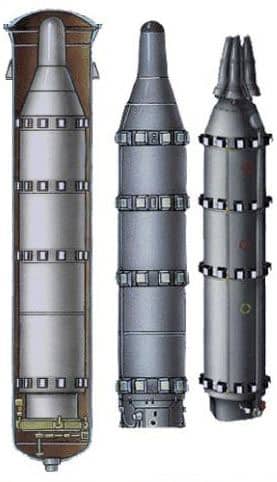
R-27 Zyb (SS-N-6)
The R-27 Zyb (NATO designation: SS-N-6 “Serb”), was a submarine-launched, liquid-fueled ballistic missile developed and deployed by the Soviet Union. Elements of the R-27 are believed to be the basis for some of North Korea’s ballistic missile programs. R-27 Development Development of the R-27 began in 1962 and flight tests began in mid-1965. The missile was first...
RK-55 Granat (SS-N-21)
The RK-55 Granat (NATO: SS-N-21 “Sampson”) is a submarine and ground-launched intermediate range cruise missile produced by the Soviet Union since 1976. RK-55 Development The RK-55 is the submarine/ground-launched component of the “55” series of cruise missiles which also included the Kh-55 air-launched missile. This family of cruise missiles was the Soviet Union’s response to the...
RSM-56 Bulava (SS-N-32)
The RSM-56 Bulava (NATO: SS-N-32) is an intercontinental-range, submarine-launched, solid propellant ballistic missile. Alongside the SS-25 and the SS-27, both land-based ICBMs, the Bulava represents a core component of Russia’s future strategic nuclear force. Development of the program began in the 1990’s with official production contacts going into effect in the 2007-2008 timeframe. The Bulava...
R-29RM Shtil (SS-N-23)
The R-29RM Shtil (NATO: SS-N-23 “Skiff”) is an intercontinental-range, submarine-based, liquid propellant ballistic missile. The Skiff was developed for the Delta IV ballistic missile submarine (SSBN), each of which is capable of carrying 16 missiles. SS-N-23 Development The SS-N-23 is capable of launching its 2,800 kg payload up to a range of 8,300 km. This payload is...
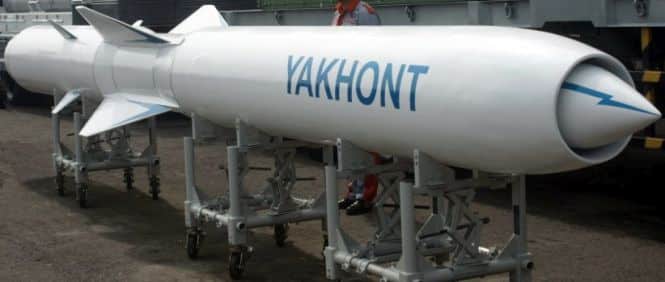
P-800 Oniks/Yakhont/Bastion (SS-N-26 Strobile)
The SS-N-26 “Strobile” (P-800 Oniks)/Yakhont/Yakhont-M are Russian anti-ship cruise missiles developed by NPO Mashinostroyenia. There are three known variants of the missile. The ship-launched variant is known as the P-800 Oniks and has been designated the SS-N-26 “Strobile” by NATO. The export variant of the ground-launched version is known as the Yakhont. An air-launched variant...
R-29 Vysota (SS-N-18)
The R-29 Vysota (NATO: SS-N-18 “Stingray”) is an intercontinental-range, submarine-launched, liquid-propellant ballistic missile. It likely derives from the SS-N-8 (R-29) missile. The SS-N-18 was designed for the Delta III ballistic missile submarine (SSBN), or Kalmar class. Each Kalmar carries sixteen SS-N-18 missiles. SS-N-18 Development There have been three SS-N-18 variants. Mod 1 has a range...
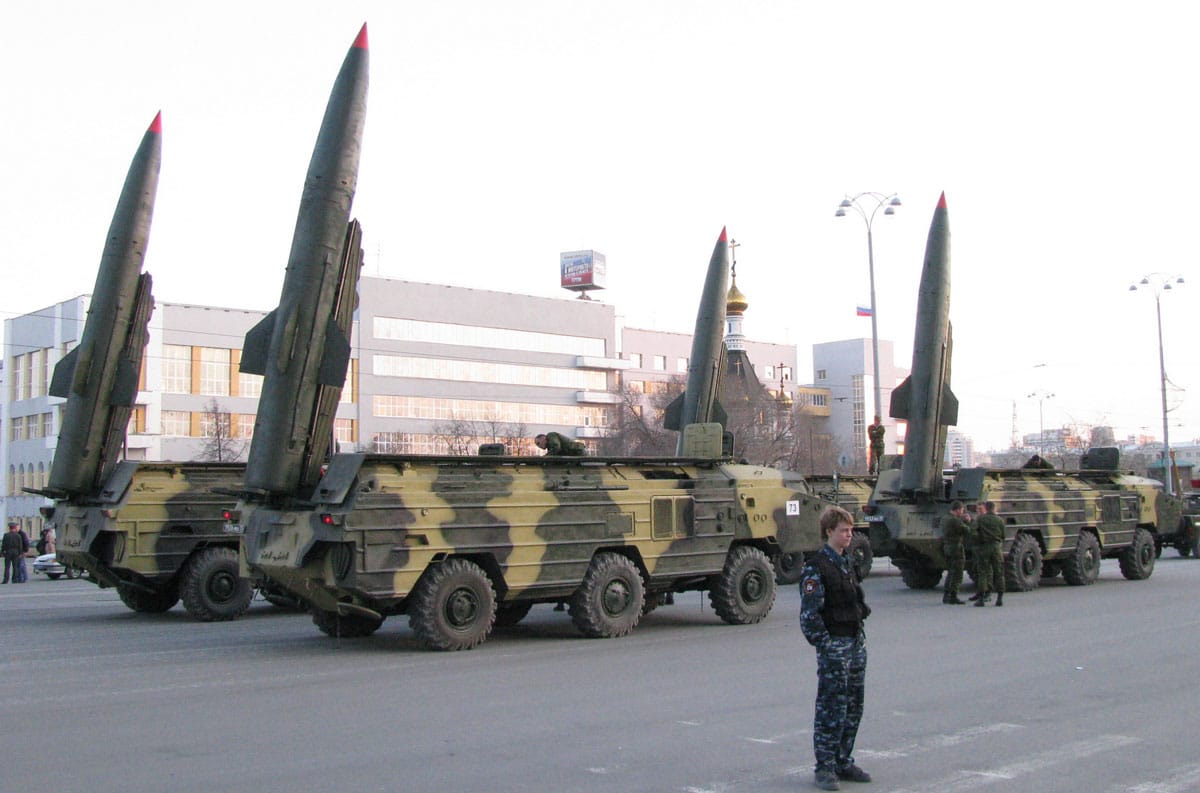
OTR-21 Tochka (SS-21)
The OTR-21 Tochka (NATO: SS-21 “Scarab”) is a short-range, road-mobile, solid propellant, single warhead ballistic missile designed for battlefield deployment. It was designed as a replacement for the Free Rocket Over Ground (FROG) missile series. Reports suggest that it can be launched in either a ballistic or cruise missile mode. The ballistic mode provides an...
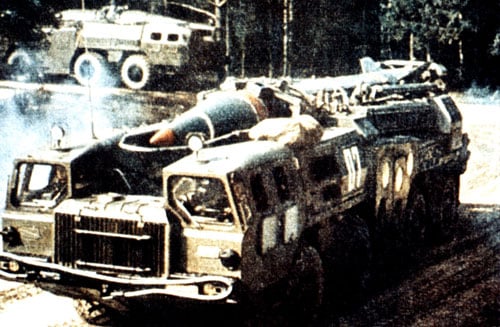
SS-1 “Scud”
The SS-1 “Scud A” was designed a short time after the end of World War II by captured German scientists and is based upon the Nazi V-2 rocket which was used to attack London during the Second World War. The Scud family of short-range, liquid-fueled missiles has now proliferated around the world and serves as...
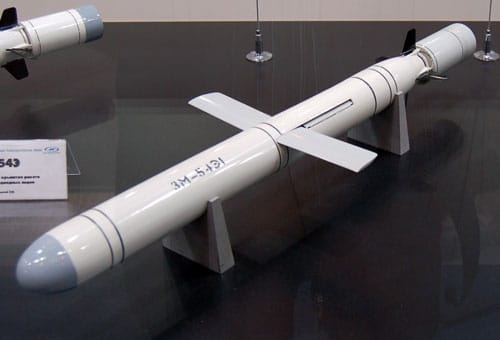
3M-54 Kalibr/Club (SS-N-27)
The 3M-54 Kalibr/Klub (SS-N-27 “Sizzler”) is a Russian short-range ship-, and submarine-launched anti-ship missile. The Sizzler is part of the Kalibr family of missiles and has several export versions known as the ‘Klub’ missile series. SS-N-27 Development Along with the rest of the Klub and Kalibr family of missiles, this anti-ship cruise missile began development...
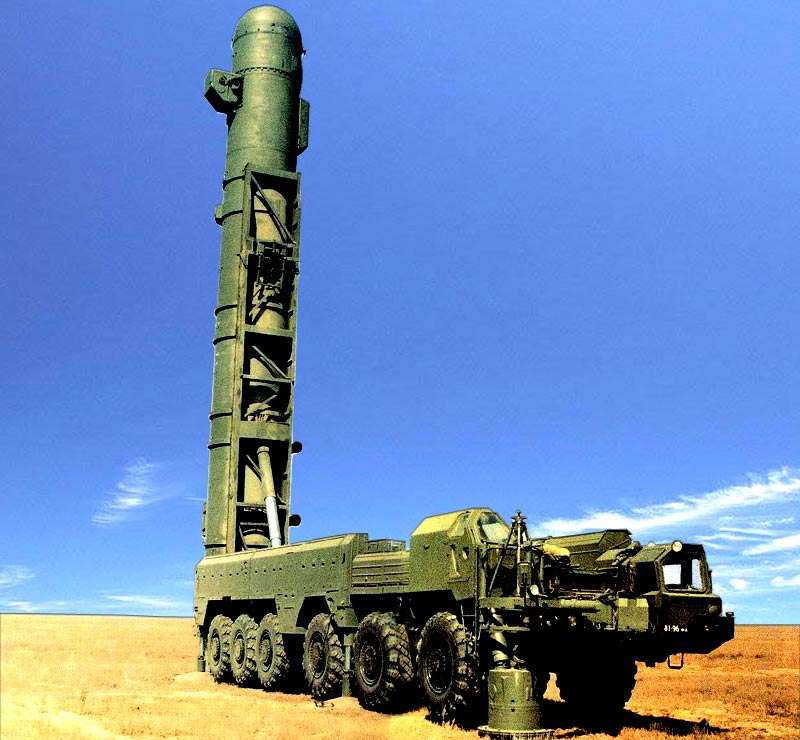
RSD-10 Pioneer (SS-20)
The RSD-10 Pioneer (NATO: SS-20 “Saber”) was a Soviet intermediate-range ballistic missile (IRBM) that entered service in 1976. Its wide-scale deployment was a key driver behind NATO’s 1979 decision to station U.S. Pershing II IRBMs in Europe. The Soviet Union retired the SS-20 from service following the ratification of the Intermediate-Range Nuclear Forces (INF) Treaty...
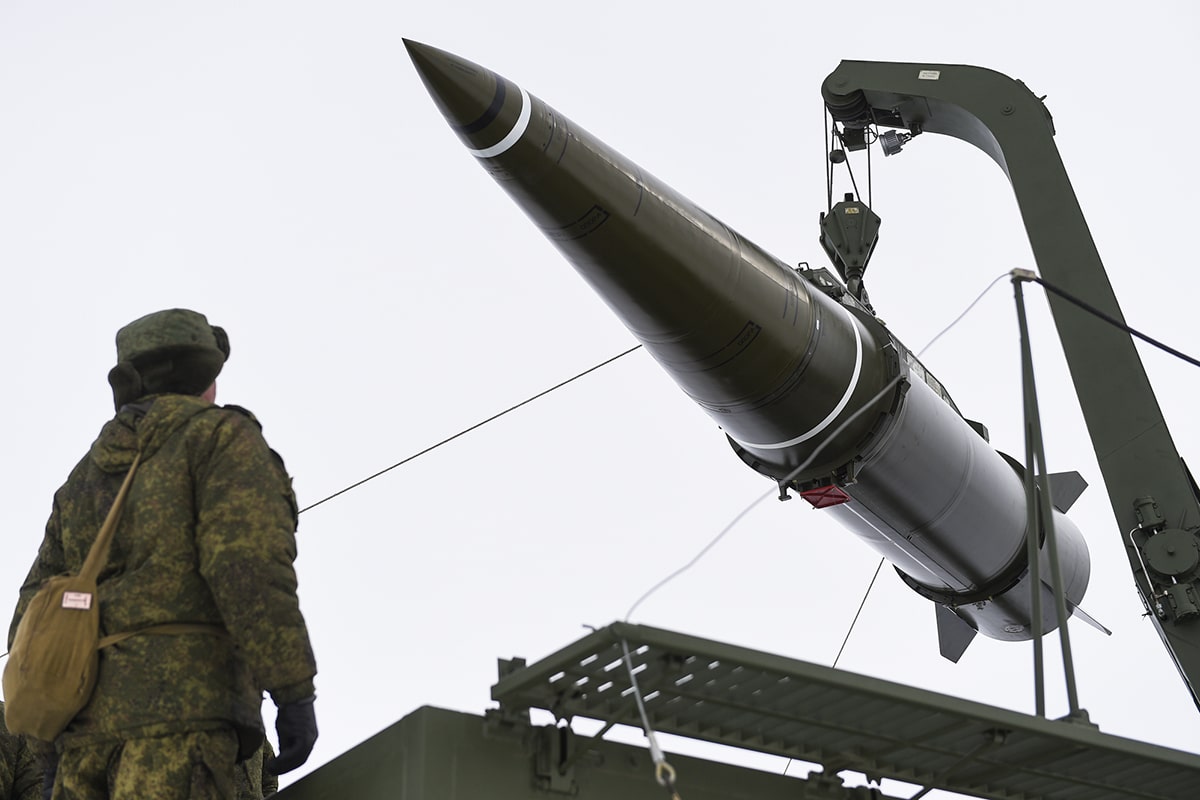
9K720 Iskander (SS-26)
The 9K720 Iskander (NATO: SS-26 “Stone”) is a road-mobile short-range ballistic missile (SRBM) with a range of up to 500 km. Using a common transporter-erector-launcher (TEL) and support vehicles, the system can also fire the 9M728 (R-500, SSC-7) and 9M729 (SSC-8) cruise missiles. Iskander Development Russia began development of the SS-26 in the late 1980s...
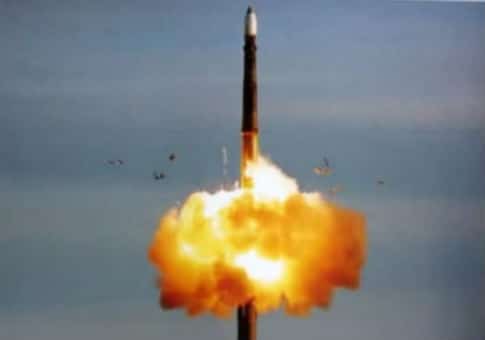
RS-26 Rubezh
The RS-26 Rubezh is a Russian solid-fueled, road-mobile intercontinental ballistic missile (ICBM) currently in development. Although classified as an ICBM under the New START Treaty, the RS-26 has been tested with heavier payloads at ranges below 5,500 km, potentially putting Russia in violation of the Intermediate-Range Nuclear Forces (INF) Treaty. RS-26 Development Development of the...
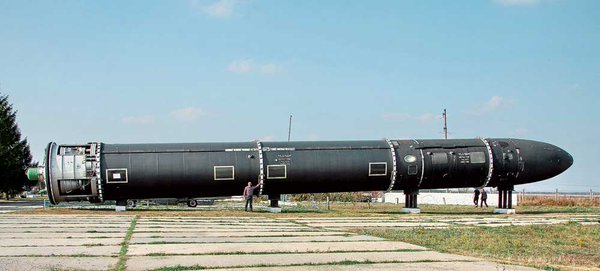
RS-28 Sarmat
The RS-28 Sarmat is a liquid-fueled intercontinental ballistic missile currently under development by Russia. Sarmat Development Designed to replace Russia’s aging SS-18 Satan ICBM, the RS-28 Sarmat began development some time in the 2000s. After awarding production contracts to Makeyev Design Bureau and NPOMash in early 2011, Russia concluded research and development of the Sarmat...
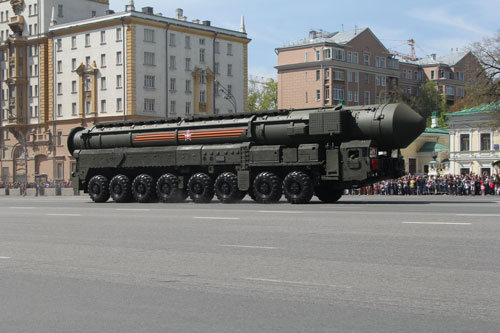
RS-24 Yars (SS-27 Mod 2)
The RS-24 Yars (NATO: SS-27 Mod 2) is a three-stage solid fuel missile that reportedly carries a payload of three reentry vehicles (RV) and penetration aids. RS-24 Yars Development The RS-24 Yars is believed to have entered into service in February 2010. While details about the missiles specifications and capabilities are limited, it is reported to...
RT-2PM2 Topol-M (SS-27 Mod 1 “Sickle B”)
The RT-2PM2 “Topol-M” (NATO designation: SS-27 “Sickle B”), is a Russian solid-fueled intercontinental ballistic missile with a range of 11,000 km. Topol-M Development The development of the Topol-M, began in the late 1980s as an upgraded version of the SS-25, though it was redesigned in 1992 as the first missile designed and built by the...
RT-2PM Topol (SS-25)
The RT-2PM Topol (SS-25 “Sickle”) is an intercontinental-range, road-mobile, solid propellant ballistic missile system. It has a range of over 11,000 km and was based on the preceding Temp-2S and Pioneer road-mobile missiles. SS-25 Development The SS-25 entered development in 1977, with flight tests occurring in between 1983-87. The missile was officially commissioned into service...
UR-100 (SS-19)
The UR-100 (NATO: SS-19 “Stiletto”) s an intercontinental-range, silo-based, liquid propellant ballistic missile system deployed by the Soviet Union and now the Russian Federation. Designed concurrently with the SS-17, with which it shares many features. SS-17, SS-18, and SS-19 were the first Soviet missiles to be equipped with Multiple Independent Reentry Vehicle (MIRV) warheads with...
R-36 (SS-18 “Satan”)
The The R-36 (NATO: SS-18 “Satan”) is an intercontinental-range, silo-based, liquid propellant ballistic missile initially developed by the Soviet Union and now the Russian Federation. It is believed that a total of six versions have existed since the program’s inception, with only the Mod 6’s still operationally deployed. SS-18 Development The SS-18 (original Mods 1/2/3)...

Kh-101 / Kh-102
The Kh-101 / Kh-102 is a line of conventional and nuclear capable air-launched cruise missiles (ALCM) developed and deployed by Russia. A stealthy missile, the Kh-101/-102 is designed to defeat air defense systems by flying at low, terrain-hugging altitudes to avoid radar systems. The Kh-101 carries a conventional warhead, while the Kh-102 is believed to...
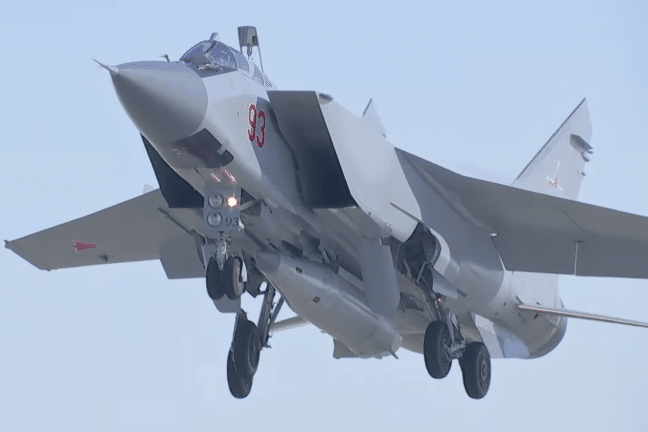
Kh-47M2 Kinzhal
The Kh-47M2 Kinzhal is a nuclear-capable, Russian air-launched ballistic missile, likely derived from Russia’s ground-launched 9K720 Iskander-M. It was one of six “next generation” weapons unveiled by President Putin during a speech in March 2018. Kinzhal Development Although it is unclear when Kinzhal’s development began, concept schemes of Russian Iskander missiles installed on the MiG-31...
Missiles of Russia
As the heir to the substantial Soviet missile arsenal, Russia boasts the widest inventory of ballistic and cruise missiles in the world. Russia remains a major power in the development of missiles of all kinds, and Russian strategic rocket forces constitute a significant element of Moscow’s military strategy. Russian missiles perform a wide variety of...
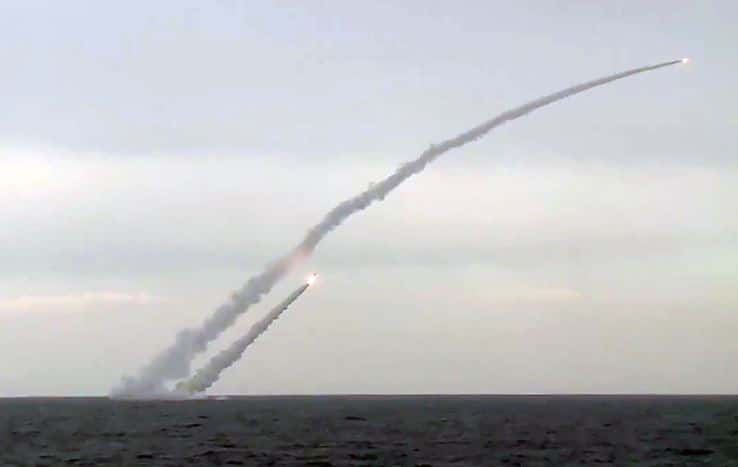
9M729 (SSC-8)
The SSC-8 is a Russian ground-launched cruise missile (GLCM) with a range of 2,500 km. Its development prompted the 2019 U.S. withdrawal from the 1987 INF Treaty. SSC-8 Development Russia reportedly began covert development of the SSC-8 in the mid-2000s, and started flight testing in 2008. It was first test fired in July 2014. It...

The Avangard is a nuclear-capable, hypersonic boost-glide vehicle developed by the Russian Federation. It was one of six “next generation” weapons described by Russian President Vladimir Putin during a speech in March 2018. Avangard Development The origins of the Avangard hypersonic glide vehicle (HGV) reach back to the mid-1980s, at which time the USSR first started...
Russia's missiles see mixed results in Ukraine war as world watches
- Medium Text

ACCURATE MISSILES
Sign up here.
Reporting by Josh Smith Editing by Gerry Doyle
Our Standards: The Thomson Reuters Trust Principles. New Tab , opens new tab

Freight train cars derailed and a storage tank containing diesel fuel caught fire in the southern Russian region of Volgograd due to "outside interference," Russian officials said on Tuesday.

World Chevron

New Caledonia closes airport, imposes curfew after violence
New Caledonia mobilised security forces, closed its international airport and imposed a curfew in the capital after protests turned violent and police were attacked, the French High Commission said on Tuesday.
Four people were injured in fresh Russian attacks on the battered city of Kharkiv in Ukraine's northeast, Ukrainian officials said on Tuesday.
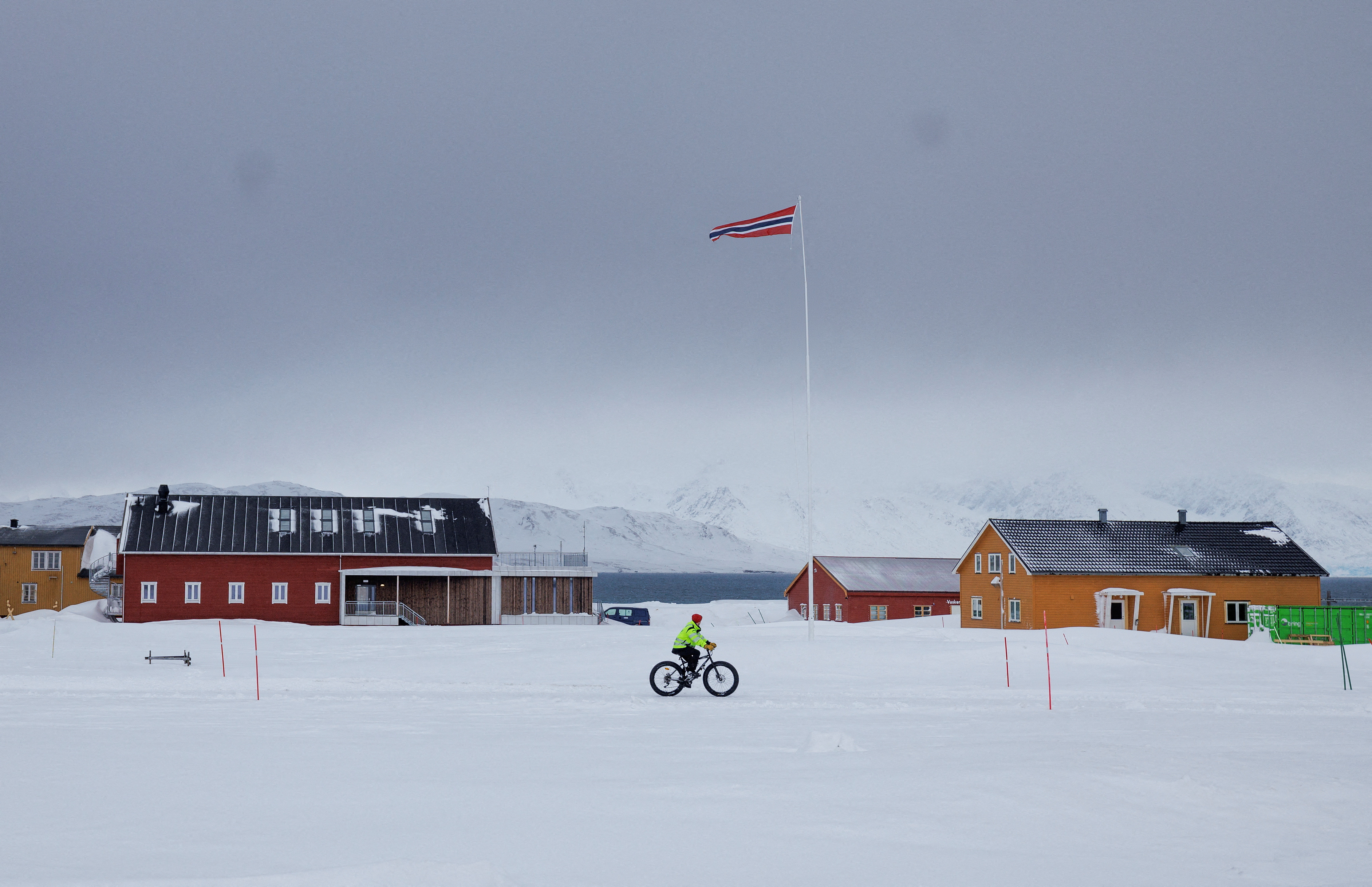
A U.S. citizen has been detained for 10 days by a Russian court for using obscene language during a police search of his apartment, the Kommersant newspaper reported on Tuesday.
Russia is using its newest and oldest missiles indiscriminately against Ukraine
- Russia has been lobbing missiles into Ukraine throughout its five-month war on its smaller neighbor.
- Moscow is using its whole inventory for that assault, firing Soviet-era and newer-model missiles.
- Those missiles have been used in strikes all across Ukraine, on military and civilian targets alike.

Among the most important weapons in the Russian arsenal during its war against Ukraine have been its cruise and short-range ballistic missiles.
Those missiles can reach all of Ukraine, enabling Russia to strike important military infrastructure, especially in western Ukraine, where Western weapons and equipment are being delivered.
Russia has launched thousands of missiles its attack began in February. Although its inventory includes a number of modern missiles capable of precision strikes, Moscow is also lobbing older, less accurate Soviet-era munitions into Ukraine.
Sea-launched
Many of the Russian missiles used in Ukraine have been launched from ships or submarines — the 3M-14 Kalibr cruise missile is easily the most well known.
Designated by NATO as the SS-N-30A, the "Kalibr" family of missiles includes anti-ship, anti-submarine, and land-attack variants that can be launched from ships, subs, and aircraft.
Kalibrs can conduct precision strikes using satellite navigation and have a range of 1,000 to 1,500 miles. They can carry a nearly 1,000-pound conventional high-explosive warhead and are often compared to the US-made Tomahawk cruise missile.
The Kalibr is one of the newest and advanced additions to the Russian missile arsenal, formally entering service in 1994. It first saw action in October 2015, when Russian warships in the Caspian Sea fired 26 Kalibrs at targets in Syria some 1,100 miles away.
The Russian Navy has also been using the P-800 Oniks anti-ship cruise missile. Designated the SS-N-26 "Strobile" by NATO, it has a nearly 200-mile range and a top speed of about Mach 2. Its warheads range from 440 pounds to 550 pounds depending on its mission.
In service since 2002, Oniks missiles are mainly launched from ships and submarines. In 2015, the Russian Navy officially adopted the Bastion mobile coastal defense missile system , enabling Oniks launches from mobile ground-based platforms.
The Kalibr missile's precision has worried NATO commanders . The missile's circular error probability — the radius of the circle in which 50% of its strikes are likely to hit — is estimated to be less than 20 feet. For the Oniks, it's estimated to be less than 5 feet.
Ground-launched
Russia's ground-launched SRBMs have had an extremely important role in the war, particularly the Tochka-U and Iskander-M missiles. Known to NATO respectively as the SS-21 Scarab and SS-26 Stone, they represent the past and present of Russian SRBMs.
Related stories
The Tochka-U was introduced in 1989, improving on the Tochka missile that entered Soviet service in 1975. Fired from a mobile transporter-erector-launcher, the Tochka-U has a range of 75 miles and can carry a 1,000-pound high-explosive warhead, a fragmentation warhead, or a 100-kiloton nuclear warhead.
A Tochka-U's TEL takes 16 minutes to prepare for launch. It can be loaded with another missile in about 20 minutes. The TEL itself also features nuclear, biological, and chemical filtration systems for its crew.
Introduced as a replacement to the Tochka-U in 2006, the Iskander-M has a 250- to 310-mile range and can carry high-explosive warheads of between 1,060 pounds and 1,540 pounds. It can also carry thermobaric warheads, fragmentation warheads, nuclear warheads, or earth-penetrating warheads.
Iskander-Ms are launched from a TEL that can carry two missiles. The TEL itself, which can also be fitted with launch tubs for cruise missiles, is hardened against nuclear, biological, and chemical attacks.
The Tochka-U has a circular error probability of about 300 feet, while the Iskander-M has a CEP of 6 feet to 16 feet.
Air-launched
Russia has been denied control of the air over Ukraine, but it has continuously fired air-launched cruise missiles at Ukrainian targets. The newest of those missile, which the Russians are keen to boast about, are the Kh-101 cruise missile and Kh-47M2 Kinzhal hypersonic missile.
The Kh-101 was introduced in 2012 and has a range 1,500 to 1,700 miles. It can carry a 990-pound high-explosive warhead or be outfitted with fragmentation or nuclear warheads. Satellite navigation and an onboard computer allow it to perform precision strikes with a CEP reportedly as small as 20 feet.
The Kinzhal is one of Russia's newest and most advanced weapons and one of the few hypersonic missiles in service.
Launched from a modified MiG-31 interceptor or strategic bomber, the Kinzhal has a range between 1,000 miles and 1,200 miles and can carry a warhead of more than 1,000 pounds. It can reportedly reach speeds of about Mach 10, and like other hypersonic missiles, it can maneuver in flight, making it virtually impossible to intercept.
The Kinzhal became the first hypersonic weapon to be used in combat on March 18, when Russian aircraft launched several of them at an underground depot in western Ukraine. Three more Kinzhals were reportedly used in strikes against Odessa on May 9.
Russia has also used less advanced Soviet-era air-launched missiles, namely the Kh-22 anti-ship missile — introduced in 1968 to take out aircraft carriers — and the Kh-55 cruise missile introduced in 1984.
The Kh-22 has a range of nearly 400 miles and a 2,000-pound warhead, while the Kh-55 has a range of over 1,500 miles and a 900-pound warhead. Neither are terribly accurate; the Kh-22's CEP is estimated to be more than 300 feet and the Kh-55's is estimated to be about 80 feet. An updated version of the Kh-22, the Kh-32 , has improved range and payload.

Battlefield effects
Overall, Russian missile strikes have had a tremendous effect on the Ukrainian war effort. Videos of Kalibrs being launched from Russian surface ships and submarines , and of Kalibrs flying over Ukraine and hitting targets have emerged throughout the conflict.
Russian SRBMs fired from Belarus and Russia have hit military bases and airfields , while Tu-22M, Tu-95, and Tu-160 bombers have reportedly launched missiles at similar targets while flying over Belarus and the Black Sea to avoid Ukrainian air defenses.
The strikes have made it difficult for the Ukrainian Air Force to operate from airfields and have reportedly targeted Western weapon shipments. Ukrainian recruits are now training as far away as Britain to avoid being attacked.
Russia's missiles also routinely hit civilian areas — including a Tochka-U strike on a railway station in Kramatorsk on April 8 that killed 59 civilians (including seven children) and a Kh-22 strike on a shopping mall in Kremenchuk on June 27 that killed 20 civilians. Russian denials about both cases have been debunked.
Russia's use of less sophisticated missiles like the Kh-22 and Tochka-U, and the use of anti-ship missiles like the Kh-22 and P-800 against Ukrainian ground targets may indicate that Moscow is having difficulty replenishing its stocks of more modern precision weapons.
Watch: VIDEO: Why Russia's military is failing so far in Ukraine
- Main content
How many missiles are left in Russia's arsenal?
As Russia bombarded Ukraine this week, military observers were left wondering about how many and what types of rockets and missiles Russia still has in its arsenal.
In other words, how long can the Kremlin keep up the barrage?
Some analysts say Russia could be running down its stockpiles of long-range precision weapons as the nearly eight-month-old war drags on and sanctions hit its economy, forcing it to resort to less-accurate ones.
It remains unclear if Russia has enough weapons to continue the strikes against Ukraine with the same intensity that began following the October 8 explosion on the Kerch Bridge to the Moscow-annexed Crimean Peninsula.
Here's a look at what is known — and what's not — about Russia's arsenal.
What does Russia claim to have left?
Russian officials have said the military has sufficient stockpiles of long-range missiles and that factories are churning out more, rejecting the West's claims its supplies are shrinking.
The Russian military hasn't said how many rockets and missiles it has fired, nor how many are left, and there is no data to independently assess the state of their arsenal.
President Vladimir Putin recently chaired a meeting to discuss plans for boosting weapons production, but he steered clear of specifics in the introductory remarks that were televised.
What has Russia relied on recently?
When the Russian military unleashed its missile attacks across Ukraine starting on Monday, it drew on the entire scope of its long-range precision weapons: the Kh-55 and Kh-101 cruise missiles fired by strategic bombers, the sea-launched Kalibr cruise missiles and the ground-launched Iskander missiles.
Russian forces have also repeatedly used the S-300 surface-to-air defence missile systems for striking ground targets, which was seen by some observers as a sign of a Russian weapons shortages.
Its repurposing of air defence systems and anti-ship missiles suggests it is running low on more-advanced missiles that are intended to hit ground targets, said a fellow at the Washington-based Center for Strategic and International Studies, Ian Williams.
Mr Williams said strikes from a Russian S-300 air defence system didn't have the "oomph to really hit hardened military targets" nor the "accuracy in a land attack role to even strike the building you want to hit".
"This really is just firing them into the ether and seeing where they land," he said.
Their use, however, could be explained by an abundant stock of older, subtypes of such missiles, which were superseded by more-advanced air defence weapons, as well as the military's desire to keep more expensive, advanced long-range missiles for priority targets.
While numbers are hard to obtain, how Russia is using its weapons is telling.
In a recent strike in Mykolaiv, a surface-to-air missile was used to hit a target on the ground.
London-based International Institute for Strategic Studies' senior fellow for military aerospace, Douglas Barrie, called that "a sure sign that missile stocks are running low".
What is Washington saying?
While the Biden administration says there is evidence that Russia has depleted stocks of its most-efficient weapons, US officials have said there is no sign Moscow is ready or willing to relent in its recent barrages against civilian areas in Kyiv and other Ukrainian cities.
It was not immediately clear what the US thinks Russia might have left in its arsenal.
However, two officials said US government analysts had noted with interest that Russia had used cruise missiles, and not the less-expensive, shorter-range artillery or rockets, in the aftermath of the Kerch Bridge blast.
That choice, the officials said, could indicate that Russia is running low on cheaper, reliable, mid-range weapons and is having trouble replenishing its stockpiles due to sanctions and supply chain disruptions.
The relative calm that Kyiv enjoyed prior to the Kerch Bridge incident may have been a sign that Russia was trying to conserve its limited resources, according to the officials, who spoke on condition of anonymity to discuss internal assessments of Russia's military strength.
What's behind the choice of targets?
Firing large numbers of inaccurate missiles could be intended to clutter air defences while Russia uses its best missiles for high-value targets and key infrastructure.
However, Mr Williams suggested that Moscow could also be acting strategically, knowing its barrage will hit civilian targets in the hopes of driving up panic in Ukraine and pushing Kyiv to accept a ceasefire favourable to Russia.
"It's becoming more and more clear that, as they say, the cruelty is the point," he said.
- X (formerly Twitter)
Related Stories
Australia's ambassador to russia working from home as embassy numbers dwindle.
UN General Assembly slaps down Russian annexation of Ukraine regions 143-5
- Defence and National Security
- Russian Federation
- United States
- Unrest, Conflict and War
More From Forbes
Russia is shifting from loitering munitions to ballistic missiles.
- Share to Facebook
- Share to Twitter
- Share to Linkedin
A man sweeps rubble next to a shopping and entertainment mall destroyed after a Russian missiles ... [+] strike on May 9, in Odessa, Ukraine, Friday, May 13, 2022. (AP Photo/Francisco Seco)
For the past 27 months, Russia has barraged Ukraine with missile strikes as part of the ongoing war between the two countries. Ukraine responded with establishing a network of air-defense systems positioned in strategic locations to reduce the effectiveness of each strike. In turn, the Russian military adopted the use of strike packages to confuse the air-defense systems, such that each barrage combines cruise missiles, ballistic missiles, hypersonic weapons, and loitering munitions. Prior to the large offensive operation planned for this summer, the Russians changed the content of their strike packages, moving away from loitering munitions and sea-launched cruise missiles, and relying more on ballistic missiles and air-launched cruise missiles.
The use of strike packages leverages Russia’s arsenal of diverse missile systems, allowing for flexible strike configurations. The Russian missile stockpiles include numerous types of cruise missiles, which can be fired from ships or aircraft, and ballistic missiles, which are typically ground-launched. While cruise missiles are highly maneuverable, enabling them to evade air-defense systems, they are slower compared to ballistic missiles, which trade maneuverability for speed. Approximately four years ago, Russia added hypersonic weapons to its arsenal. These weapons combine the speed of ballistic missiles with the agility of cruise missiles; however, these weapons are limited in number and expensive. Additionally, Russia has acquired loitering munitions, such as the Shahed drones from Iran, which are capable of very precise strikes while flying over a range of altitudes.
KYIV, UKRAINE - MARCH 24: Ukrainian forces continue to investigate the area where rocket fragments ... [+] fell in a park in Kyiv, Ukraine on March 24, 2024. (Photo by Danylo Antoniuk/Anadolu via Getty Images)
By combining the different missile types into each strike package, the Russian forces are trying to overwhelm and confuse Ukrainian air-defense systems, which have a very limited time to detect and respond to incoming rounds. This strategy has proven effective, with a significant number of rounds being able to breach Ukrainian defenses. For example, the Ukrainians were able to intercept two-thirds of the Russian missiles fired on February 7, 2024, allowing 15 missiles to still reach their target.
In recent months, the composition of strike packages has undergone notable changes. There has been a decreased usage of Shahed drones and similar loitering munition. Meanwhile, there has been an increase in the usage of ballistic missiles, particularly Iskander missiles launched from Crimea. The proximity of Crimea to these targets significantly reduces the reaction time available to Ukrainian air-defense systems, amplifying the effectiveness of the strike. Similarly, as the Russian Air Force has started to play an increasing role in the conflict, naval-launched cruised missiles are being replaced with air-launched cruised missiles, including the Kh-22 missile. Ukrainian air-defenses have had very limited success with countering the Iskander and Kh-22 missile.
Netflix: Marvel Dud Among Movies New On Streaming Service This Week
Square enix is done with playstation exclusivity after profit drop, apple s new chatgpt deal here s what it means for iphone security.
MOSCOW REGION, RUSSIA - AUGUST 17: (RUSSIA OUT) A Russian Iskander-E missile launcher is one ... [+] display at the International Military Technical Forum 'Army 2022' on August 17, 2022 in Moscow, Russia. (Photo by Contributor/Getty Images)
The movement away from loitering munitions in favor of ballistic missiles stems in part from improvements in Ukrainian counter-drone technology, which has had increasing success at detecting and neutralizing loitering munitions. Indeed, the Ukrainians have been able to shoot down between 75 and 100 percent of the Shahed drones used in recent strikes. This is in comparison to the short-range ballistic missiles, which the Ukrainians are struggling to intercept given their very short time of flight. Further, by not using loitering munitions during the current barrages, the Russians will be able to modify the drones to be more resilient to Ukrainian counter-drone systems, allowing them to be used later this summer during the main portion of their offensive.
In this photo provided by the Ukrainian Emergency Service, emergency services work at the scene of a ... [+] Russian attack in Odesa, Ukraine, Friday, March 15, 2024. (Ukrainian Emergency Service via AP Photo)
The change in strike package composition is also linked to the general shortage of Ukrainian munitions and equipment. Earlier in the war, launching ballistic missiles from Crimea would have been risky because the Ukrainian forces would be able to identify and target the launch vehicles. However, the current situation allows Russia to utilize Crimea as a base for ballistic missile attacks, as Ukrainian are focusing their limited resources on holding their defensive lines in the Donbas region. Similarly, the shortage of anti-air assets by the Ukrainians has allowed the Russian Air Force to play a larger role, including the launching of cruise missiles.
In the near-term, Russia will continue to use this composition in their strike packages, relying more on ballistic missiles than loitering munitions. The composition will likely change later in the summer as the Russians launch their offensive operation, at which time loitering munitions would be expected to play an increasingly important role. Around that time, Ukraine will be receiving their much-needed aid from the United States and other NATO countries, allowing them to better respond the wide array of missiles that could be used by Russia. Similar to all technologies used in the war, the Russian strike packages and the Ukrainian air-defense systems will continue to evolve to account for the dynamics of the battlefield.

- Editorial Standards
- Reprints & Permissions
Join The Conversation
One Community. Many Voices. Create a free account to share your thoughts.
Forbes Community Guidelines
Our community is about connecting people through open and thoughtful conversations. We want our readers to share their views and exchange ideas and facts in a safe space.
In order to do so, please follow the posting rules in our site's Terms of Service. We've summarized some of those key rules below. Simply put, keep it civil.
Your post will be rejected if we notice that it seems to contain:
- False or intentionally out-of-context or misleading information
- Insults, profanity, incoherent, obscene or inflammatory language or threats of any kind
- Attacks on the identity of other commenters or the article's author
- Content that otherwise violates our site's terms.
User accounts will be blocked if we notice or believe that users are engaged in:
- Continuous attempts to re-post comments that have been previously moderated/rejected
- Racist, sexist, homophobic or other discriminatory comments
- Attempts or tactics that put the site security at risk
- Actions that otherwise violate our site's terms.
So, how can you be a power user?
- Stay on topic and share your insights
- Feel free to be clear and thoughtful to get your point across
- ‘Like’ or ‘Dislike’ to show your point of view.
- Protect your community.
- Use the report tool to alert us when someone breaks the rules.
Thanks for reading our community guidelines. Please read the full list of posting rules found in our site's Terms of Service.
clock This article was published more than 2 years ago
What to know about the long-range cruise missile Russia says it fired
Russian naval forces launched long-range cruise missiles on Tuesday evening from the waters off Sevastopol, a port city in Russia-held Crimea, according to expert analysis of video verified by The Washington Post.
Russia said the 3M-14 Kalibr cruise missile attack destroyed a major Ukrainian arsenal.
Understanding the weapons that have drawn the world’s attention since Russia’s invasion of Ukraine
A v ideo filmed by a witness from the Sevastopol waterfront on Tuesday shows at least four projectiles being fired from the water. Geolocation of the video by The Post shows the missiles appear to be traveling northwest, away from the city. As the narrator recites the date and location, the camera pans to show his surroundings.
“We thought it was a plane flying,” the narrator says. “It’s normal that planes fly here. But shooting is something serious.”
Additional video filmed around the same time shows eight flares with long tails that appear to be airborne missiles flying over the Black Sea. Both videos were verified by The Post.
Footage shared by the Russian defense ministry on social media shows large fireballs emanating from a warship where the ministry said Russian forces had fired Kalibr cruise missiles toward military assets in Orzhev, a village outside of the city of Rivne. Rivne is located more than 200 miles west of Kyiv and would be within the range a 3M-14 Kalibr missile could travel if it was fired from Sevastopol.
The tightly cropped video first shows multiple large explosions in succession above a ship, while someone off camera counts, “First, second, third, fourth.” The video then cuts to a wider view of a sunset where the long tails of the eight missiles are visible. The Post was not able to verify the location of this launch.
What you need to know about hypersonic missiles, which Biden says Russia used against Ukraine
Video reportedly of a Russian Project 21631 Buyan-M small missile ship launching 8 Kalibr-NK cruise missiles from near Sevastopol. https://t.co/GcWqUpoXLh pic.twitter.com/VvU3l5yYCK — Rob Lee (@RALee85) March 22, 2022
“As a result of the strike, a large depot of weapons and military equipment of the Ukrainian troops, including those received from Western countries, was destroyed,” a statement on the ministry’s Telegram channel said.
U.S. officials said they could not confirm that the weapons had been used. Ukrainian authorities have not confirmed the deployment of the missiles or the destruction of an arsenal near Rivne.
The Post could not independently verify Russia’s claim that a weapons depot had been destroyed.
Ian Williams, deputy director of the missile defense project at the Center for Strategic and International Studies, said he was nearly positive the videos showed the launch of 3M-14 Kalibr cruise missiles.
“These are Russia’s long-range naval sea-based cruise missiles, similar to the U.S. Tomahawk,” he told The Post in an email. “They use satellite navigation along with some onboard inertial guidance.”
“This was almost certainly launched by the Russian Black Sea Fleet,” Mark Cancian, senior adviser for the international security program at CSIS, said in an email. Kalibr missiles are “at the high end of Russian capabilities,” he added. “Russia uses them to attack the highest priority targets. They seem to be doing more of that in western Ukraine. It may be part of an effort to attack strategic targets, that is, targets that matter in the long war.”
The 3M-14 or SS-N-30A cruise missile , commonly referred to as the Kalibr missile, can be fired from ships or submarines toward land targets. It can travel a maximum range of about 1,550 miles, according to the CSIS Missile Defense Project.

3M14 Kalibr
Stabilizers
20 feet, 4 inches
6 foot person for scale

Pop-out wings
Control fins
The missiles, designed to penetrate the air defenses of stationary ground targets, fly autonomously and largely horizontally at low altitude, along preprogrammed waypoints. Their route can be updated midcourse via satellite communication. Cruise missiles can be highly accurate compared to ballistic missiles.

Low altitude
flight path,
by satellite
Approximate 1,550 mile range
Not to scale

3M14T Kalibr
flight path, parallel to

Low altitude flight path, parallel to ground
Tracks terrain
during flight
Route can be updated through satellites
The standard 3M14T land-attack missile reportedly contains a nearly 1,000-pound high explosive warhead. It is often used to attack storage facilities, command posts, seaports and airports.
Russia stuck barracks in the southern port city of Mykolaiv with a Kalibr missile earlier this month, the New York Times reported , killing at least eight Ukrainian soldiers who had been sleeping there. The region’s governor said at least 19 others were wounded.
A Pentagon official said at a background briefing Wednesday that the United States still assessed that Russia has “the vast majority” of its inventory of surface-to-air missiles and cruise missiles.
Russia first used the SS-N-30A Kalibr missile in Syria in October 2015, when it launched 26 missiles from Russian naval vessels in the Caspian Sea, at forces fighting the government of Syrian President Bashar al-Assad.
Dan Lamothe contributed to this report.

- International
June 13, 2023 Russia-Ukraine news
By Kathleen Magramo , Rob Picheta , Schams Elwazer, Aditi Sangal , Mike Hayes and Elise Hammond , CNN
Russia launched 14 cruise missiles at Ukraine overnight, Ukrainian military says
From CNN's Olga Voitovych in Kyiv
Ukrainian air defenses shot down 10 of 14 cruise missiles fired by Russia in deadly strikes overnight, the General Staff of the Armed Forces of Ukraine said Tuesday.
Air defenses also intercepted one of four Iran-made Shahed drones launched by Russia, officials said.
In the central city of Kryvyi Rih, at least six people were killed, dozens were wounded and rescue teams were working to free people still trapped under the rubble.
“One apartment building, a warehouse with food. [...] We are currently dismantling the rubble and extinguishing the fire. Many people lost their apartments. We are now engaged in resettlement,” said Oleksandr Vilkul, head of the Kryvyi Rih city military administration, on Telegram.
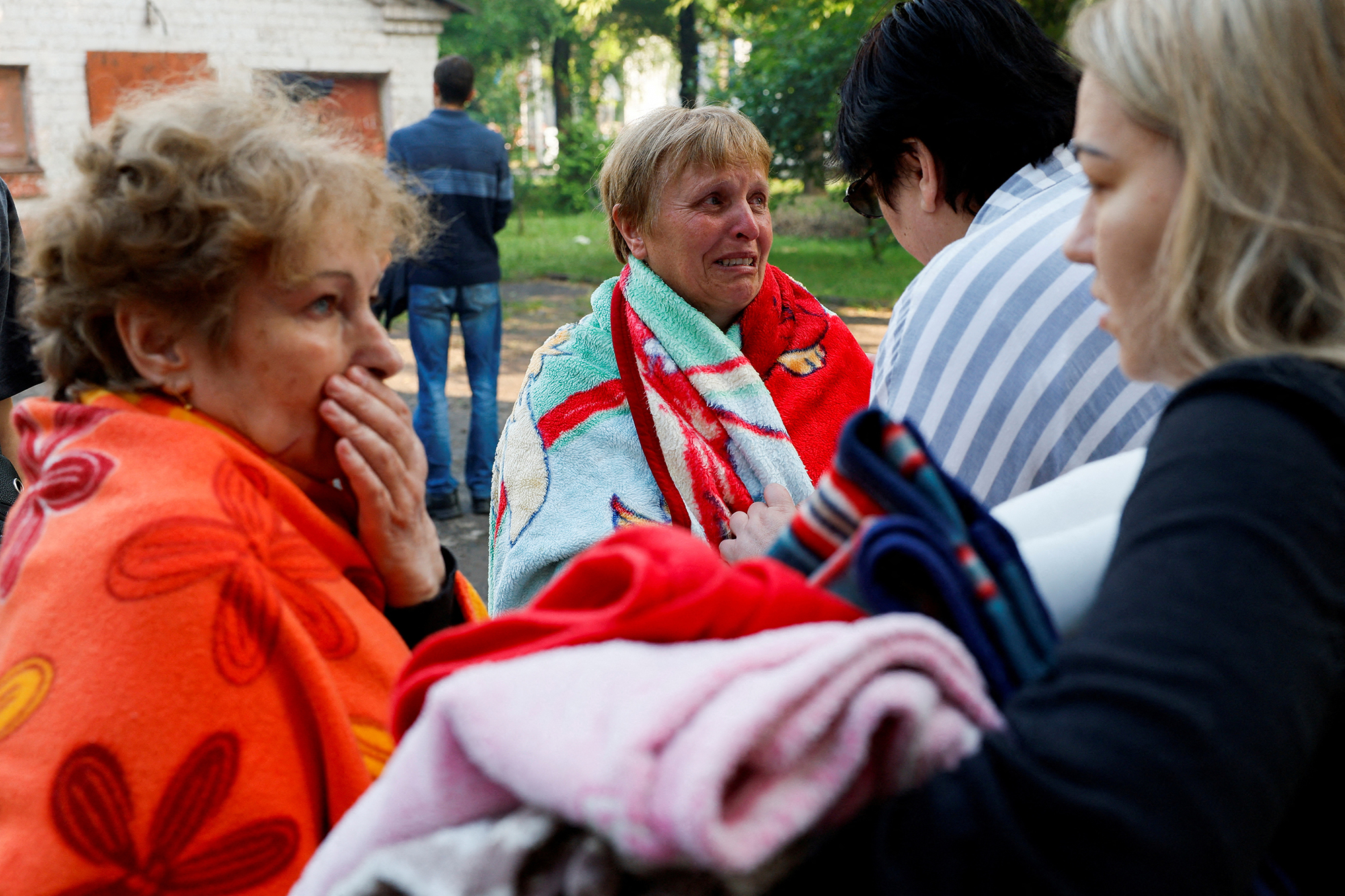
More Russian attacks: Elsewhere, Russian shelling hit Ukraine's northeastern Sumy and Kharkiv regions, the Armed Forces of Ukraine said in a statement.
In the southern Zaporizhzhia region, three bombs hit the town of Orikhiv, killing one civilian and destroying homes, it added.
Russian military bloggers claimed Monday that Ukrainian efforts to advance south of Orikhiv have been resisted and geolocated video appears to show Ukrainian armor losses in this area.
Death toll rises to 6 after Russian strikes on Kryvyi Rih, official says
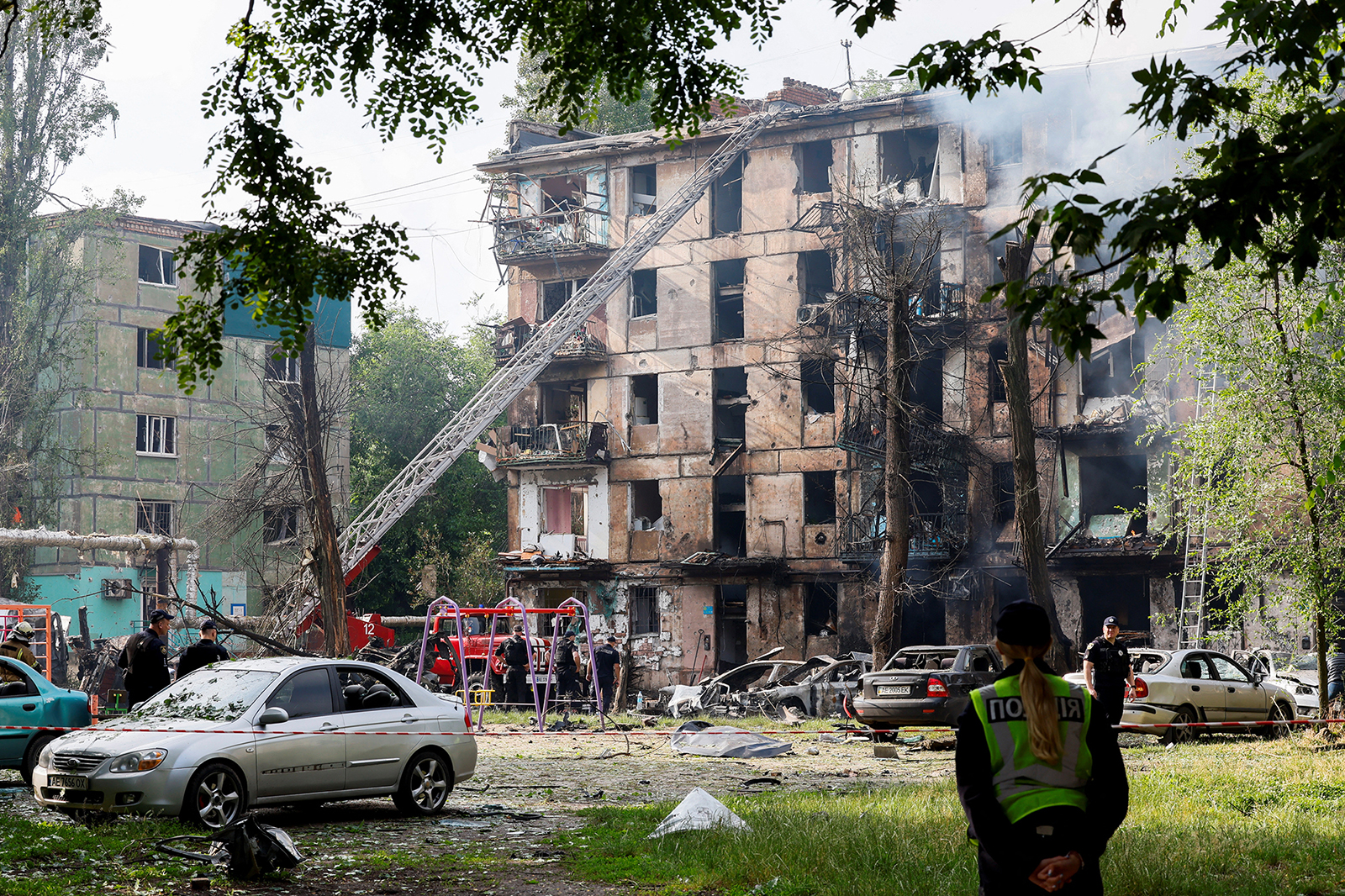
At least six people have now been confirmed dead after Russian missile strikes hit the city of Kryvyi Rih in central Ukraine overnight, as rescue teams work to free people still trapped under the rubble, Ukrainian officials said.
Vilkul said earlier that at least three people had died, dozens of others were wounded and rescuers were working to free at least seven people trapped in the rubble.
Their exact location remains unclear; rescue operations were taking place at a five-story apartment building that caught fire and at a warehouse hit in the strikes, authorities said.
"Three of the victims work at a private enterprise. They were hospitalized. There are probably people under the rubble of the destroyed warehouse, and rescuers are looking for them," Serhii Lysak, head of the Dnipropetrovsk region military administration, said in a Telegram post earlier Tuesday.
Air defenses shot down three cruise missiles over the city but there were also “incomings,” that hit civilian infrastructure, Lysak said earlier.
Ukrainian President Volodymyr Zelensky has condemned the attacks and offered condolences to the victims.
At least 3 dead, 25 wounded in Russian missile attacks on Kryvyi Rih
From CNN's Olga Voitovych in Kyiv, Ukraine and Josh Pennington

At least three people were killed and 25 others wounded after Russian missile attacks on central Ukraine's Kryvyi Rih early Tuesday, according to Ukrainian officials.
Serhii Lysak, head of the Dnipropetrovsk region military administration, said on Telegram that air defenses shot down three cruise missiles over the city but there were also "incomings."
"Civilian facilities were damaged," he said, adding that 19 of the wounded were hospitalized.
"There was a massive missile attack on Kryvyi Rih. The Russians carried out another terrorist attack on the residential sector — overnight. This was insidious. Cruel," Lysak said earlier on Telegram.
Mayor Oleksandr Vilkul said earlier that a five-story apartment building was hit and victims were likely trapped under the rubble.
"Apartments from the first to the fifth floors are on fire. The fire has covered 700 square meters. Rescuers are extinguishing it," the mayor said in an update.
Four people were also injured at another location in the city where a building and a car had caught fire, he added.
The mayor also reported Russian shelling of the nearby Nikopol district overnight.
Zelensky on attacks: In a Telegram post, Ukrainian President Volodymyr Zelensky offered his condolences to the victims.
"More terrorist missiles, Russian killers continue their war against residential buildings, ordinary cities, and people," he said. "Unfortunately, there are dead and wounded. The rescue operation in Kryvyi Rih continues. My condolences to all those who have lost their loved ones! Terrorists will never be forgiven, and they will be held accountable for every missile they launch."
Russian missiles target Ukraine as intense fighting rages on the battlefield. Here's the latest
From CNN staff

Russian strikes hit Ukraine's Kryvyi Rih early Tuesday, leaving victims in "extremely critical condition," the mayor said. Meanwhile, Kyiv's air defenses shot down all Russian missiles launched at the capital, officials said.
The latest Russian airstrikes come after both Russian and Ukrainian forces reported intense clashes on the battlefield Monday. Ukrainian forces have recaptured seven villages within the last week, according to��Deputy Defense Minister Hanna Maliar.
Here are the latest developments in the war:
- Heavy fighting: Russia-backed officials and military bloggers are reporting intense fighting along the border of the Donetsk and Zaporizhzhia regions , in an area where Ukrainian forces have made gains in recent days . The fighting is taking place south of the town of Velyka Novosilka along both sides of the Mokri Yaly River, an area where the Ukrainians appear to have had greater success than elsewhere in the initial stages of their counteroffensive. Several Russian accounts have admitted Kyiv's forces were making some gains.
- Zelensky on gains: In his nightly address Monday, Ukrainian President Volodymyr Zelensky said the fighting in the Donetsk-Zaporizhzhia border region is tough but Ukrainian forces are recapturing territory. "The battles are fierce, but we are moving forward, and this is very important. The enemy's losses are exactly what we need," he said.
- Elsewhere in Donetsk: Ukrainian troops have made incremental gains in the eastern city of Bakhmut, according to the army and Maliar. The deputy defense minister said Monday that within the past week, Ukrainian forces in the Bakhmut area had recaptured 16 square kilometers .
- "Ultimate goal": Zelensky's chief diplomatic adviser told CNN Monday that the "ultimate goal of the counteroffensive campaign is to win back all the territories, including Crimea." Adviser Igor Zhovkva would not give details on the actions underway and sought to tamp down any expectations that the counteroffensive would achieve rapid results.
- Putin visits wounded soldiers: Russia's Vladimir Putin told wounded soldiers their country needs them during a visit to the central Ministry of Defense Hospital in Moscow on Monday — one of several public appearances by the president to mark Russia Day. He bestowed state awards on fighters wounded in Ukraine and said he understood the conflict is "not some movie, it's all happening in reality."
- Dam "catastrophe": The collapse of the Nova Kakhovka dam in southern Ukraine last week was the "largest catastrophe by Russian invaders" since the war began, Ukraine’s environment minister told CNN on Monday. "The Russian act of terrorism has catastrophic consequences for the environment, not only in Ukraine but also in the entire region," minister Ruslan Strilets said. Kyiv and Moscow have blamed each another for the breach, although it is unclear whether the collapse resulted from structural failure or a deliberate attack.
Kyiv's air defenses shoot down Russian cruise missiles, Ukrainian military says
From CNN’s Josh Pennington and Eyad Kourdi
Ukraine's air defenses shot down all missiles launched by Russia at Kyiv early Tuesday, according to initial reports cited by a senior Ukrainian military official.
Serhiy Popko, head of the Kyiv city military administration, said Russia launched an unspecified number of X-101/555 cruise missiles at Ukraine's capital from Tu-95MS strategic bombers over the Caspian Sea.
No casualties or damage have yet been reported following the attack, he added.
Earlier Tuesday, the administration warned residents in the Kyiv region to take immediate precautions due to missile danger.
Civilians in "critical condition" after strike on Ukraine's Kryvyi Rih, mayor says
From CNN’s Josh Pennington
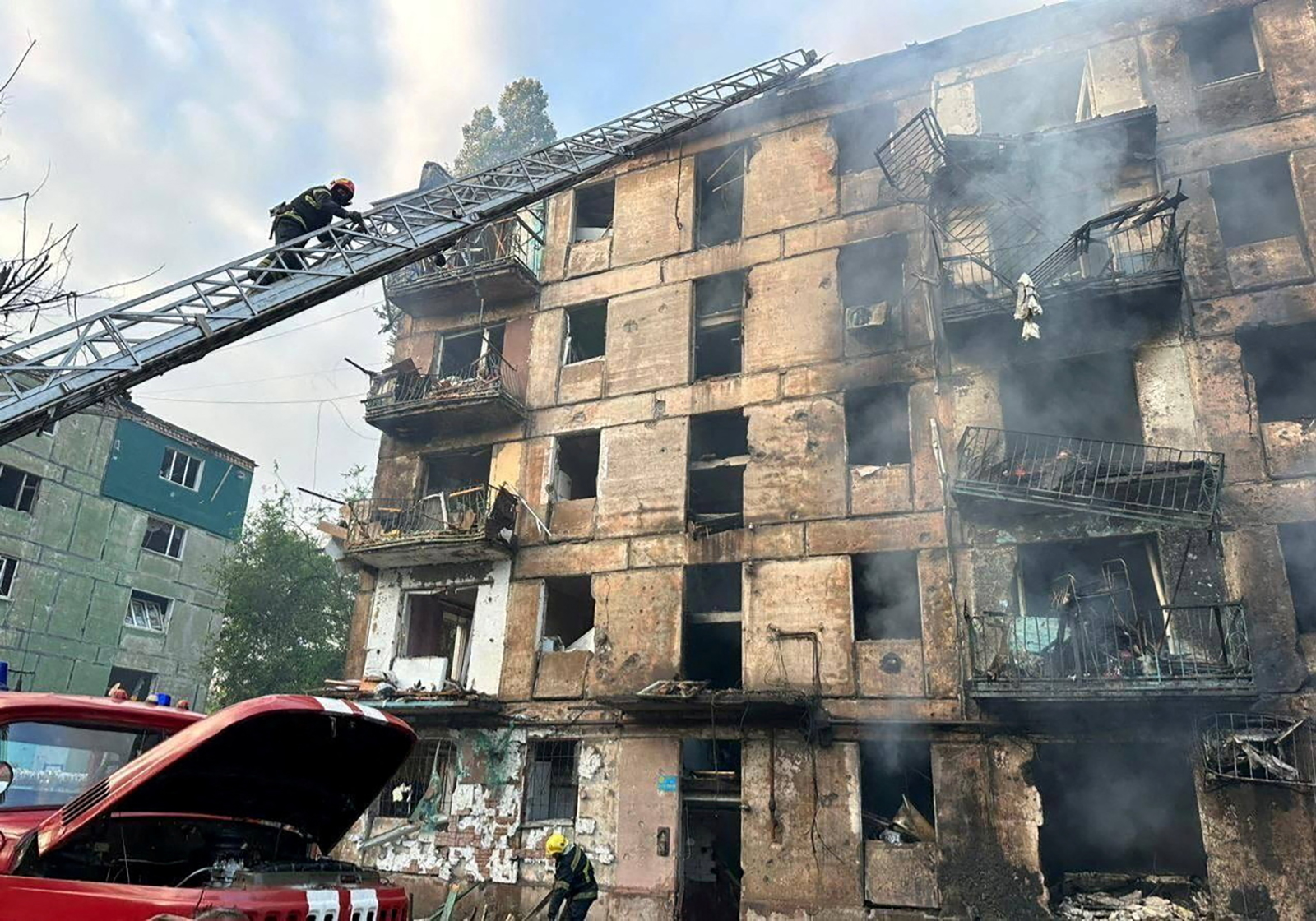
"High precision" Russian strikes hit central Ukraine's Kryvyi Rih early Tuesday, leaving civilian victims in “extremely critical condition,” the city's mayor said.
Mayor Oleksandr Vilkul said on Telegram that "high-precision monsters" struck several civilian targets in various parts of the city, including a five-story residential building.
Some victims were likely still under the rubble, he said, adding that response teams were working at the scene.
Russian accounts report heavy fighting in Zaporizhzhia and acknowledge Ukrainian gains
From CNN's Tim Lister, Josh Pennington and Maria Kostenko
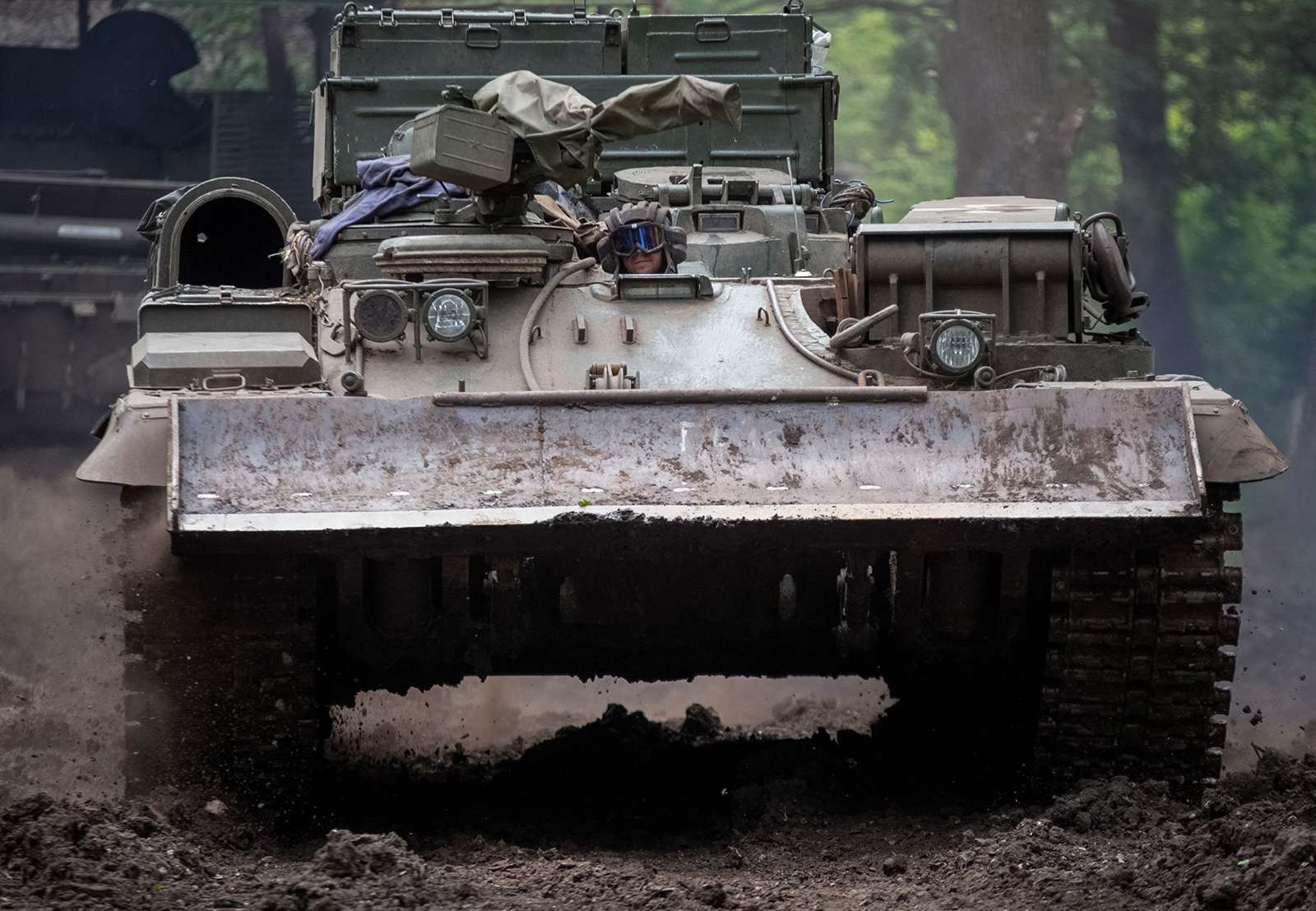
Russia-backed officials and military bloggers are reporting intense fighting along the border of the Donetsk and Zaporizhzhia regions , in an area where Ukrainian forces have made gains in recent days .
The fighting is taking place south of the town of Velyka Novosilka along both sides of the Mokri Yaly river, an area where the Ukrainians appear to have had greater success than elsewhere in the initial stages of their counteroffensive.
Late Monday, a senior Moscow-appointed official, Vladimir Rogov, spoke of heavy fighting in an area known as the Vremivka ridge, claiming that higher ground remained under Russian control.
Rogov, a member of the Russian-installed Zaporizhzhia administration, said on Telegram that Russian attack helicopters were in action, and that "reciprocal shelling and heavy fighting of ultra-high intensity continues" in the vicinity of the village of Urozhaine.
Rogov conceded that Ukrainian forces were "holding their positions on the northern and eastern outskirts of the village."
He also claimed that in the nearby village of Makarivka, "the enemy has already been driven out by the quick and effective counterattack of the 127th Division," although other accounts paint a gloomier picture for Russian forces around Makarivka.
Rogov said heavy fighting about 10 kilometers to the west had turned the area into a "gray zone," but that Ukrainian units had dispersed from the area — around the village of Levadne.
Bloggers' reports: Russian military bloggers have also been reporting intense combat in the area, with one Telegram channel (Our Donetsk) saying "the enemy managed to deepen and advance through the wooded areas, threatening with further advance to encircle" nearby Russian units.
There is no way to verify these unofficial reports, but they are consistent with a pattern in the fighting that has evolved in the last week.
"Our Donetsk" acknowledged that Russian troops had been forced to abandon Neskuchne — just south of Velyka Novosilka — for a second time, "retreating to positions where they would not be encircled."
It said the Ukrainians were "accumulating forces" in the area, and heavy fighting continued.
Also late on Monday, Ukrainian President Volodymyr Zelensky commented on the fighting in the Donetsk and Zaporizhzhia border region, saying "the enemy's losses are exactly what we need."
By contrast, Russian military bloggers are claiming that Ukrainian efforts to advance south of Orikhiv, in another part of the southern front, have been resisted, with several saying the Ukrainians had lost a significant number of de-mining tanks in an area known to have been heavily fortified by the Russians with minefields and tank traps.
Geolocated video appears to show Ukrainian armor losses in this area.
Zelensky says battles are fierce but Ukraine is moving forward and recapturing territory
From CNN's Maria Kostenko
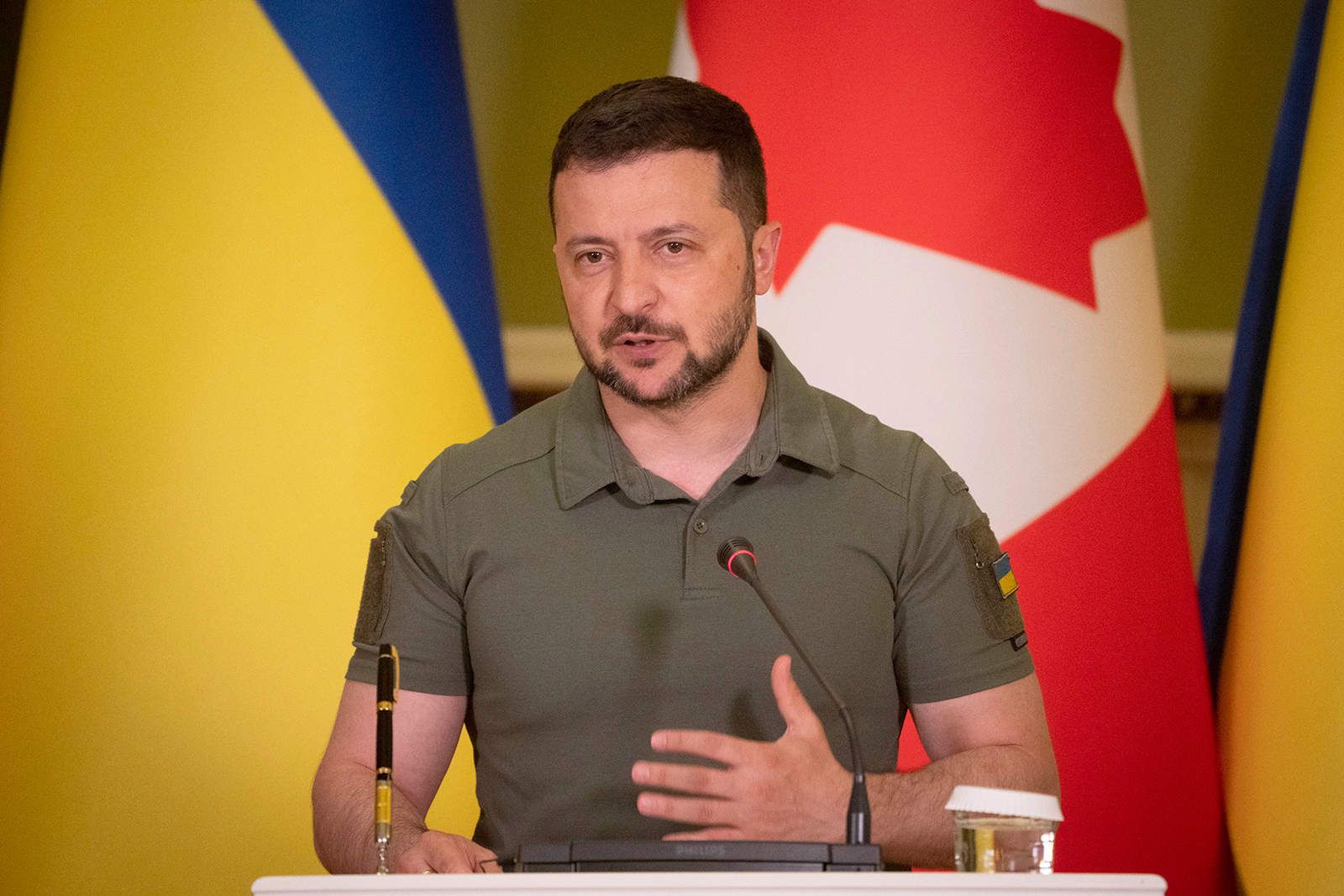
Ukrainian President Volodymyr Zelensky said in his nightly address on Monday that fighting is tough but Ukrainian forces are "moving forward" and recapturing territory.
"The battles are fierce, but we are moving forward, and this is very important. The enemy's losses are exactly what we need," Zelensky said. "Although the weather is unfavorable these days — the rains make our task more difficult — the strength of our warriors still yields results, and I thank everyone who is in combat now, everyone who supports our combat brigades in the relevant areas."
Zelensky also said "the most important and hottest" operational areas are in the Tavria and the Khortytsia directions in southern Ukraine, and he received reports from the commanders in those areas during his staff meeting on Monday.
The commander of the Ukrainian Ground Forces and the general of the Tavria operational-strategic group reported "on the success we have achieved, on the front areas where we need to reinforce and on the actions we can take to break more Russian positions," Zelensky said.
"We are maintaining and strengthening our operational dominance," Zelensky said. "I am particularly grateful for Bakhmut as we are increasing our control in this area."
Some more context: Earlier on Monday, Ukraine's Deputy Defence Minister Hanna Maliar said that within the past week, Ukrainian forces in the Bakhmut area recaptured 16 square kilometers . On the left flank in Bakhmut, Ukrainian troops advanced 1.5 kilometers, and on the right flank, they advanced 3.5 kilometers, according to Maliar.
"This week, as always, will be very meaningful," Zelensky added in his address. "First, we are preparing new weapons support from our partners for our warriors. Second, we are preparing to involve more global actors in the implementation of the Peace Formula. Third, we are working to make the [NATO] Vilnius Summit truly meaningful."
Ultimate goal of counteroffensive is to win back all territories, including Crimea, presidential adviser says
From CNN’s Sharon Braithwaite in London and Andrew Carey in Kyiv
Ukraine's "ultimate goal of the counteroffensive campaign is to win back all the territories, including Crimea," the chief diplomatic adviser to President Volodomyr Zelensky said Monday.
During an interview with CNN's Christiane Amanpour, adviser Igor Zhovkva said some counteroffensive actions were underway, but would not give details.
He also sought to tamp down any expectations the campaign would achieve rapid results, saying it could take many months for Ukraine to achieve its aims.
In the same vein, he reminded Amanpour this was not Ukraine’s first counteroffensive — a reference to the Ukrainian army's successful advances in September and October when Russian forces were pushed out of the Kharkiv region and the northern part of the Kherson region.
The current push would “probably would not be the last counteroffensive operation,” he said.
He also said that if Ukraine was going to be successful it needed Western partners to supply more artillery and ammunition.
Please enable JavaScript for a better experience.
- Today's news
- Reviews and deals
- Climate change
- 2024 election
- Fall allergies
- Health news
- Mental health
- Sexual health
- Family health
- So mini ways
- Unapologetically
- Buying guides
Entertainment
- How to Watch
- My watchlist
- Stock market
- Biden economy
- Personal finance
- Stocks: most active
- Stocks: gainers
- Stocks: losers
- Trending tickers
- World indices
- US Treasury bonds
- Top mutual funds
- Highest open interest
- Highest implied volatility
- Currency converter
- Basic materials
- Communication services
- Consumer cyclical
- Consumer defensive
- Financial services
- Industrials
- Real estate
- Mutual funds
- Credit cards
- Balance transfer cards
- Cash back cards
- Rewards cards
- Travel cards
- Online checking
- High-yield savings
- Money market
- Home equity loan
- Personal loans
- Student loans
- Options pit
- Fantasy football
- Pro Pick 'Em
- College Pick 'Em
- Fantasy baseball
- Fantasy hockey
- Fantasy basketball
- Download the app
- Daily fantasy
- Scores and schedules
- GameChannel
- World Baseball Classic
- Premier League
- CONCACAF League
- Champions League
- Motorsports
- Horse racing
- Newsletters
New on Yahoo
- Privacy Dashboard
Russia boosts Kh-101 cruise missile for more precise strikes in Ukraine
Russia has improved the performance of its main air-launched cruise missile Kh-101 by fielding it with a second warhead. missile with a new warhead, stated British Defense Ministry intelligence report on X on May 8.
Intelligence indicates that the Russian Airspace Forces sought to adapt its systems and tactics during the war with Ukraine in order to:
Read also: Ukrainian command reports Russian drones camouflaged for night warfare
enhance survivability, responding to numerous missile interceptions by Ukrainian air defense systems;
expand capabilities for more impactful targeting;
utilize older missiles, conserving more modern systems depleted in the war's initial stages.
Read also: Advanced Russian bomb wipes out Kharkiv street, kills elderly woman
The recent modification likely halved the range of the Kh-101 missile, as the Russian RAF doesn't require maximum range to target all of Ukraine, according to a report. Meanwhile, the new warhead is designed to increase fragmentation damage to targets, potentially enhancing the system's effectiveness against unprotected targets.
Advanced Russian bomb wipes out Kharkiv street, kills elderly woman
Kyiv downs all missiles as Russia attacks Ukrainian capital from different directions in latest mass attack
In January, Vadym Skibitskyi, deputy head of the Main Intelligence Directorate of the Ukrainian Defense Ministry (HUR), stated in Davos that the Russians were deploying different Kh-101 cruise missiles compared to those used in 2022. He highlighted that the new missiles are outfitted with an active electronic warfare system and heat traps.
We’re bringing the voice of Ukraine to the world. Support us with a one-time donation, or become a Patron !
Read the original article on The New Voice of Ukraine
Recommended Stories
Biden's coming new tariffs on china reflect 'lessons learned'.
A sweeping White House move on China tariffs that is expected to be unveiled early next week "reflects lessons learned," according to a former official who was involved in the process.
Australian ambassador: 'American model is proving its resilience' despite threat from Chinese industrial policy
China may be outspending the US when it comes to industrial policy in sectors like electric vehicles and semiconductors, but America is winning on innovation where it can’t on price, according to one China expert.
Social Security just passed Medicare as the government's most pressing insolvency risk
An annual government report offered a glimmer of good news for Social Security and a jolt of good news for Medicare even as both programs continue to be on pace to run dry next decade.
Former House Speaker Paul Ryan says he’s not voting for Trump : 'Character is too important'
Ryan says he would be writing in a Republican candidate instead of voting for Donald Trump.
Fed officials stick to Powell’s higher-for-longer script as a key inflation reading looms
Jay Powell’s colleagues spent the last week backing a stance the central bank chair hammered home at his last press conference: Interest rates will be staying higher for longer.
Trump trial live updates: Judge finds Trump violated gag order again and threatens jail time, while jury sees paper trail in hush money case
The former president’s criminal hush money trial resumes Monday in Manhattan, where the prosecution will continue presenting its case.
Fed’s Kashkari: Rates will stay high for 'extended period' and can't rule out a hike
Minneapolis Fed president Neel Kashkari said interest rates will likely stay at current levels for an "extended period" and didn't rule out a hike if inflation stalls near 3%.
Trump trial updates: Michael Cohen testifies that Trump directed him to pay hush money to Stormy Daniels and approved scheme to conceal reimbursement
This is Yahoo News’ succinct update on the criminal and civil cases against Trump. Here are the latest developments.
Trump trial live updates: Michael Cohen testifies in hush money case, recounts arranging deal to silence Stormy Daniels
The former president’s criminal hush money trial resumes Monday in Manhattan, where his former lawyer and fixer is expected to take the stand.
Quiz: How well do you know RFK Jr.'s policy positions?
Test your knowledge of the policy positions of third-party presidential candidate Robert F. Kennedy Jr.
Trump wants to levy his new tariff regime 'quickly.' Here's how long it might take.
Donald Trump and his allies have made new tariffs a centerpiece of his potential second-term economic agenda. They are openly exploring legally untested options for making them a reality.
Texas Gov. Greg Abbott vows student Gaza protester demands will 'NEVER' be met. Here's how we got here.
Texas Gov. Greg Abbott said in a social media post Sunday that the University of Texas would not meet the demands of student protesters.
Trump trial live updates: Prosecution calls more witnesses to establish Trump ties with Stormy Daniels, Karen McDougal
The former president’s criminal hush money is set to resume in Manhattan Friday when former National Enquirer publisher David Pecker returns to the witness stand to face cross-examination by the defense.
Pro-Palestinian protests spread as hundreds arrested at Emory University, Emerson College and elsewhere across the U.S. Here's what's happening.
Pro-Palestinian protests and encampments are springing up at numerous colleges, leading to arrests and heightened security concerns. Here’s what's happening.
What does Trump need most from his running mate?
The typical rules would suggest the former president should choose someone unlike himself to round out his ticket, but typical rules rarely apply to Trump.
White House proposes up to $120M to help fund Polar Semiconductor's chip facility expansion
The Biden administration announced Monday that Polar Semiconductor will receive up to $120 million in federal funds to expand its chip manufacturing facility in Minnesota. The funding stems from the bipartisan CHIPS and Science Act, which Biden signed into law in August 2022 to strengthen the U.S. supply of semiconductors. The expansion of Polar Semiconductor’s facility would enable the company to double its U.S. production capacity of sensor and power chips within two years, the U.S. Department of Commerce said in a press release.
The big battle over whether to snatch Russia’s billions
Some Ukraine allies want to seize $300 billion in Russian assets and give the money to the besieged country. Financial bigwigs are split on the idea.
Trump trial full coverage: Defense tries to paint Stormy Daniels's lawyer as a serial extortionist in hush money case
It's the 10th day of the hush money trial.
FCC officially votes to reinstate net neutrality
The Federal Communications Commission made its official vote Thursday to reinstate net neutrality, which bars broadband providers from slowing or even blocking internet traffic to some sites while improving access to others that pay extra fees. With some changes and protections, passing the order titled Safeguarding and Securing the Open Internet restores rules passed back during the Obama administration in 2015 and rolled back in 2017, after Donald Trump was elected president. Since the FCC announced in September that it would be pursuing this as a policy goal, it was more or less a fait accompli; there was no real reason why the Commission, split 3-2 in favor of the Democrats, would vote against it.
Trump trial live updates: Stormy Daniels takes the stand to testify in hush money case

Russia's Cruise Missiles Just Became More Lethal
R ussia has modified its Kh-101 cruise missiles to accommodate two separate warheads, making them more lethal on the battlefield in Ukraine, according to the U.K.'s latest defense intelligence update.
The Russian Aerospace Forces (VKS) Long Range Aviation Command (LRA) has "increased the lethality" of its "premier" long-range missiles by fitting them with a second warhead, the U.K.'s Ministry of Defence said in an update on Wednesday.
The Kh-101 missiles have previously been described by the MOD as "Russia's premier precision guided munition." They have a range of around 4,000 kilometers (nearly 2,500 miles) and are also known by their NATO code designation as AS-23a Kodiak missiles.
Moscow has used the missiles to launch large-scale attacks on Ukrainian energy infrastructure throughout the war. They are designed to defeat air defense systems by flying at low, terrain-hugging altitudes to avoid radar systems, the Center for Strategic and International Studies has previously noted.
Newsweek reached out to Russia's Defense Ministry via email for comment.
"The LRA Command has sought to modify its systems and tactics throughout the conflict to: increase survivability as too many missiles were being intercepted by Ukrainian air defence systems; enhance capabilities to have greater effect; and use up older missiles as the VKS had depleted more modern systems in the early days of the conflict," British military intelligence said.
The MOD intelligence analysis said this latest modification has, however, likely reduced the missile's range by half.
"The LRA does not need the full range to hit all of Ukraine. The second warhead is designed for increased fragmentation at the target. It is likely that this will make the system more effective in striking non-hardened targets," the update said.
On Wednesday, Defense Express, a Ukrainian security and defense publication, published a photo it said it obtained of one of the modified Kh-101 cruise missiles. It said the missile had been downed during a missile attack Russia launched against Ukraine overnight on Tuesday.
The publication said that alongside its 450-kilogram warhead, it has been modified to carry a second 350-kilogram warhead, totaling 800 kilograms, increasing its destructive power, but shortening its flight range by about half.
The modified missiles were first observed on the battlefield in Ukraine in late March, according to the outlet.
Ukraine's Defense Ministry said Wednesday that its air defense systems downed 39 of 55 Russian missiles from the large-scale barrage. These comprised 33 Kh-101 cruise missiles, four Kalibr cruise missiles, and two Kh-59/69 cruise missiles, as well as 20 Iranian-made Shahed kamikaze drones.
Do you have a tip on a world news story that Newsweek should be covering? Do you have a question about the Russia-Ukraine war? Let us know via [email protected].
Start your unlimited Newsweek trial


Russia Is Flexing Its Nuclear Muscles With Unprecedented Drills. So, What Now?
The West is watching with wary eyes...
On Monday, Russia announced its Southern Military District would hold snap tactical nuclear weapons drills involving its ground, navy, and air forces that will help “iron out” how exactly it might conduct a tactical nuclear strike.
While such drills are not unprecedented, announcing them in advance was , as Moscow usually only gives advance warning of its long-range strategic weapons capable of reaching the U.S. soil.
Fortunately, the drills do not involve actual weapons launches, and a Pentagon spokesman told the media he doesn’t see any movement of Russia indicating actual planning to use nukes now any more than it has after making dozens of past nuclear threats.
Russia’s tactical (or ‘non-strategic’) nuclear weapons have the range to hit targets out to Germany, if ground-launched by Iskander missile launchers in the Baltic enclave of Kaliningrad) or across most of Europe using Kh-32 cruise missiles air-launched by Russian bombers or (possibly) Kinzhal hypersonic missiles mounted on MiG-31 interceptors. Various Russian warships also can launch nuclear-capable Kalibr and P-800 Oniks cruise missiles.

Russian rhetoric specifically indicates the drill is in response to comments by British Foreign Secretary David Cameron that it would permit Ukraine to use-long range weapons supplied by the U.K. (presumably, highly effective Storm Shadow cruise missiles ) for strikes on Russian soil. Meanwhile, French President Emmanuel Macron has also inspired Russian ire with comments suggesting he might consider deploying a limited number of French troops to aid Ukraine.
Other grievances cited by Russia’s foreign ministry include Poland’s requests to join NATO’s nuclear-sharing policy (which involves U.S. B61 tactical nuclear gravity bombs mounted on F-16, F-35 or Tornado jet fighters of allies) and false claims that F-16s newly supplied to Ukraine can carry nuclear weapons. While some F-16s are wired to deliver nuclear weapons, that is not true of those delivered to Ukraine in particular.
Prior to now, such NATO-supplied weapons have been provided on the stipulation they’re used only on targets in Ukrainian soil—a policy that has led Ukraine to rely only on its own improvised drones and missiles for such attacks.
Did ATACMS kill Russia's Iskander?
But the Russian drills might be more than a response to Western rhetoric. On social media , RAND defense analyst Dara Massicot connects the drills to a Ukrainian strike on Crimea on the evening of May 4 involving newly delivered American ATACMS ballistic missiles that may have destroyed Russian Iskander missile launchers.
After receiving an initial batch of older, shorter-range (max 103 miles) M39 ATACMS missiles that Ukraine used to destroy around 20 landed Russian helicopters last Fall , there was a pause in ATACMS deliveries due to opposition from Republicans in Congress.
But nearly a half year later in, April U.S. aid finally resumed, now including deliveries of much longer-range M57 ATACMs missiles with a max range of 186 miles and GPS-enhanced precision, considerably expanding Ukraine’s strike options.
The May 4 strike may have knocked out Iskander ballistic missiles launchers trucks, which are dual-capable, meaning they can be used for both nuclear and conventional attacks.
Satellite imagery on May 5 confirms fires and scorch marks on the ground where Iskander launchers were spotted in earlier satellite photos made public on May 2. Russian sources claim to have shot down four ATACMS missiles over Crimea missile that evening. However, other Russian social media posts suggest two Iskander-M launchers and an ammunition warehouse were hit.
The latest images don’t conclusively confirm whether any Iskander launchers were knocked out.
Dara Massicot, Senior Fellow, Carnegie Endowment for International Peace, Russia and Eurasia Program, writes :
“If [Ukraine] destroyed or damaged an Iskander SRBM [short-range ballistic missile], it would be a first for this war. And I suspect, if this site was targeted -regardless of damage, they want to make sure everyone knows those launchers are dual-use. The launchers are a critical vulnerability for Russia’s ability to strike Ukraine. They cannot replace launchers quickly and there’s not that many.”
It’s important to emphasize Iskanders are ‘fair game’, as Russia has used conventionally armed Iskander missiles extensively to attack both military and civilian targets in Ukraine; the system’s hypersonic ballistic missiles are much harder for Ukrainian defense to intercept than more common subsonic cruise missiles and Shahed drones.
And Iskanders in occupied Crimea are situated on what is legally Ukrainian soil (much as Putin vehemently insists otherwise after seizing the peninsula in 2014) and thus not in violation of any U.S.-Ukrainian agreement forbidding attacks on Russian soil using U.S. weapons.
Why Russia keeps on threatening to go nuclear
While Russia is undoubtedly mad about Cameron's recent statement authorizing Ukraine to use British weapons for strikes on Russian soil, ironically, Russia itself has repeatedly led the pack in violating treaties and norms on long-range weapons and nuclear arms when it deployed longer-range Iskander-K nuclear missiles in violation of the INF treaty during the 2010s ( leading to the treaty's collapse ), then deployed nuclear weapons to Belarus , and apparently acquired ballistic missiles from North Korea and launched them at Ukraine .
While expensive nuclear arsenals have never again been used in war since the two U.S. atomic bombings of Japan in 1945, in recent years, Russia has particularly sought to derive additional value from its nukes by hinting they might get used in response should it suffer major military defeats or face escalated western support for Ukraine.
More explicitly, but less officially, senior Russian politicians like former president Dmitry Medvedev and propagandists like Margarita Simonyan have fantasized on state television regarding unleashing nuclear weapons to secure victory in Ukraine.
Growing reliance on nuclear threats reflects Russia’s relative weakness in conventional military power vis-à-vis NATO in the post-Soviet era.
Though Putin’s bluffed nuclear redlines have been crossed many times in the last two years, nuclear threats have nonetheless affected the thinking of certain Western policy makers—notably German Chancellor Olaf Scholz and U.S. National Security Advisor Jake Sullivan—and thereby curbed the volume and kinds of military aid certain states are willing to provide Ukraine.
After all, there’s still no telling which redlines are false and which are real, a state of ambiguity Putin appears happy to exploit despite the inherent risks.
Russia’s Iskander missile threat
Generally, Russia is believed to possess just over 160 Iskander-M launchers (NATO codename SS-26 Stone) including 12 attached to Russia’s Coastal Defense force, as the Iskander does have a terminal seeker that may enable engagement of moving naval targets.

The basic eight-wheeled Iskander MZKT-79306 ASTROLOG transport-erector-launcher (TEL) truck carries two 9M723 missiles. A separate MZKT truck carries two reload missiles, while various six-wheeled trucks by Kamaz serve as command and equipment transport vehicles.
The standard missile used is the 9M723 quasi-ballistic missile, landing on average within 7 meters when aided by satellite navigation, or 30 meters when not. That’s a major improvement over its Soviet predecessor, the OTR-21 Tochka (codename SS-21 Scarab). Iskander ostensibly has a maximum range of 310 miles, but that has likely been extended substantially since Russia withdrew from the INF treaty.
9M723s are also much harder to shoot down thanks to an extreme peak speed of Mach 6-7, and ability to maneuver evasively mid-flight and ability to release six air defense decoys (known as ‘penetration aids’). The 9M723 can be armed with a nuclear warhead of up to 50 kilotons yield, a regular high explosives warhead, cluster sub-munitions—or more rarely, thermobaric, ground-penetrating, and EMP payloads. Each missile allegedly costs $3 million, a particularly steep price by Russian standards.
An Iskander-K variant armed with the slower 9M729 Novator cruise missile also exists and was a key factor in the collapse of the INF arms control treaty due to its range likely exceeding 1,000 miles.

Early in the war, Iskanders particularly targeted Ukrainian airbases and air defense radars. More recently, Russia has used Iskanders supported by drone-forward spotters for successful time-sensitive strikes that destroyed one or more launchers belonging to a Ukrainian Patriot air defense battery and an HIMARS M142 rocket-launching truck.
Fortunately, Russia’s use of Iskanders missiles is constrained by monthly production after using up most of its back inventory early in the war. Presently ‘fresh’ Iskander strikes are limited by a production rate of roughly 30 new 9M723 ballistic missiles per month (up from only 6 produced monthly at the war’s onset) supplemented by 12 additional 9M729 cruise missiles monthly.
As a result, Russia has also withdrawn from retirement the much-less-accurate Tochka-U ballistic missile for strikes on Ukraine, including a notorious cluster munition attack that killed 58 civilians fleeing the war at the Kramatorsk’s train station on April 8, 2022.
Sébastien Roblin has written on the technical, historical, and political aspects of international security and conflict for publications including 19FortyFive, The National Interest, MSNBC, Forbes.com, Inside Unmanned Systems and War is Boring. He holds a Master’s degree from Georgetown University and served with the Peace Corps in China. You can follow his articles on Twitter .

.css-cuqpxl:before{padding-right:0.3125rem;content:'//';display:inline;} Pop Mech Pro .css-xtujxj:before{padding-left:0.3125rem;content:'//';display:inline;}

Can the Army’s New Rifle Take on Russian Armor?

Overhaul Your Shop

The Source of All Consciousness May Be Black Holes

F-22s are Flocking to This Island in the Pacific

Special Ops Gunship Shreds “Fishing Boat”

Henrietta Lacks Never Asked to Be Immortal

Ukraine Is Using an Ancient Weapon on Russia

Inside the CIA’s Quest to Steal a Soviet Sub

Jumpstart Your Car With a Cordless Tool Battery

Lost Villa of Rome’s Augustus Potentially Found

Could Freezing Your Brain Help You Live Forever?

IMAGES
COMMENTS
August 10, 2021. As the heir to the substantial Soviet missile arsenal, Russia boasts the widest inventory of ballistic and cruise missiles in the world. Russia remains a major power in the development of missiles of all kinds, and Russian strategic rocket forces constitute a significant element of Moscow's military strategy.
On 4 April, the Pentagon claimed Russia had launched more than 1,400 missiles and that its residual inventory is the lowest in cruise missiles. In late May, Ukrainian President Volodomyr Zelensky stated that Russia had launched 2,154 missiles and Ukraine believes Russia has depleted 60 percent of its precision-missile arsenal .
This blog post was first published on the Military Balance Plus on 8 July 2022 If Russia's use of the Raduga Kh-32 (RS-AS-4A Kitchen mod.) anti-ship missile in a secondary mode as a land-attack weapon in its war on Ukraine suggested Moscow's inventory of dedicated land-attack cruise missiles (LACMs) was dwindling, this was only reinforced days later when even older model Raduga Kh-22s (RS ...
8 of 19 |. FILE - Russian Buk-M3 surface-to-air missile system rolls along Red Square during a rehearsal for the Victory Day military parade in Moscow, Russia, Friday, May 7, 2021. As Russia bombarded Ukraine this week, military observers were left wondering about how many and what types of missiles Russia still has in its arsenal.
Russian Cruise Missiles Were Made Just Months Ago Despite Sanctions. Weapons investigators in Kyiv found that at least one Russian Kh-101 cruise missile used in widespread attacks there on Nov. 23 ...
existing cruise missile inventory. Alongside the lesson of 'quantity having a quality of its own', the comparative success of Ukrainian ground-based air defence in engaging Russian cruise missiles, even if the claims are considerably exaggerated, will propel interest in greater survivability. Options include greater numbers,
Land-attack cruise missiles feature increasingly in national inventories. Yet NASIC's '2020 Ballistic and Cruise Missile Threat' report refers to just three cruise-missile states - China, Iran and Russia - rather than the 11 countries featured in the previous report released in 2017. The new report gives no reason for the narrowed ...
On June 13, Russia launched a cruise missile attack against Kryvyi Rih. At least one of the four missiles that got through Ukraine's defenses struck an apartment building, killing 11. Overall, the performance of Ukraine's air defenses has steadily improved since the start of the war, particularly against Russian cruise missiles.
Sizing Up Russia's Cruise Missile Inventory. Share. February 08, 2023. The Tu-95MS strategic bomber can carry six Kh-55 missiles in its bomb bay and eight larger Kh-101s on its underwing pylons.
The Kh-101 / Kh-102 is a line of conventional and nuclear capable air-launched cruise missiles (ALCM) developed and deployed by Russia. A stealthy missile, the Kh-101/-102 is designed to defeat air defense systems by flying at low, terrain-hugging altitudes to avoid radar systems. The Kh-101 carries a conventional warhead, while the Kh-102 is ...
The United States intelligence community believes that the Russian Air Force is encountering a significant failure rate when using air-launched cruise missiles, almost certainly the Raduga Kh-101 (RS-AS-23A Kodiak), in long-range attacks against targets in Ukraine. The Kh-101 was used successfully during Russia's intervention in the Syrian civil war to strike enemy targets and is now the ...
Kalibr (missile family) The Novator Kalibr (Калибр, caliber ), also referred to as 3M54-1 Kalibr, 3M14 Biryuza (Бирюза, turquoise ), ( NATO reporting name SS-N-27 Sizzler and SS-N-30A) is a family of Russian cruise missiles developed by NPO Novator ( OKB-8 ). It first saw service in 1994. There are ship-launched, submarine-launched ...
As the heir to the substantial Soviet missile arsenal, Russia boasts the widest inventory of ballistic and cruise missiles in the world. Russia remains a major power in the development of missiles of all kinds, and Russian strategic rocket forces constitute a significant element of Moscow's military strategy. Russian missiles perform a wide variety of missions, from anti-access/area denial ...
As the heir to the former Soviet Union's substantial missile arsenal, Russia boasts the widest inventory of ballistic and cruise missiles in the world, according to CSIS.
The Russian Navy has also been using the P-800 Oniks anti-ship cruise missile. Designated the SS-N-26 "Strobile" by NATO, it has a nearly 200-mile range and a top speed of about Mach 2.
A Russian military officer walks past the 9M729 land-based cruise missile on display in Kubinka outside Moscow in 2019. (AP: File) The relative calm that Kyiv enjoyed prior to the Kerch Bridge ...
Russian forces are beginning to have "inventory issues with precision-guided munitions," a senior US defense official told reporters on Monday. Precision-guided munitions refer to missiles ...
The Russian missile stockpiles include numerous types of cruise missiles, which can be fired from ships or aircraft, and ballistic missiles, which are typically ground-launched.
Russian cruise-missile house Raduga showed a previously unseen missile design and showcased its additional manufacturing capacity during a recent visit from a senior Moscow delegation. Douglas Barrie and Timothy Wright explore the implications for the war in Ukraine. This blog post was first published on the Military Balance+ on 9 February 2023.
Russia said the 3M-14 Kalibr cruise missile attack destroyed a major Ukrainian arsenal. Understanding the weapons that have drawn the world's attention since Russia's invasion of Ukraine. A v ...
Cruise missiles of Russia include cruise missiles designed, built, or operated by Russia. Subcategories. This category has the following 3 subcategories, out of 3 total. A. Anti-ship cruise missiles of Russia (8 P) N. Nuclear cruise missiles of Russia (6 P) S.
From CNN's Olga Voitovych in Kyiv. Ukrainian air defenses shot down 10 of 14 cruise missiles fired by Russia in deadly strikes overnight, the General Staff of the Armed Forces of Ukraine said ...
Russia has improved the performance of its main air-launched cruise missile Kh-101 by fielding it with a second warhead. missile with a new warhead, stated British Defense Ministry intelligence ...
Russia's invasion of Ukraine has seen the use of ballistic and cruise missiles as well as direct attack munitions by both participants. The use of guided weaponry in a contested environment has revealed the advantages and limitations of some types of systems. This paper surveys the ways in which guided weapons have been used in the conflict and explores some of the lessons that Russia and ...
Russia has modified its Kh-101 cruise missiles to accommodate two separate warheads, making them more lethal on the battlefield in Ukraine, according to the U.K.'s latest defense intelligence ...
Russia's tactical (or 'non-strategic') nuclear weapons have the range to hit targets out to Germany, if ground-launched by Iskander missile launchers in the Baltic enclave of Kaliningrad) or ...
Iran last month launched a large-scale overnight air strike on Israel. More than 300 drones, cruise missiles, and ballistic missiles targeted the country. North Korean technology was at least ...